February 17th, 2012
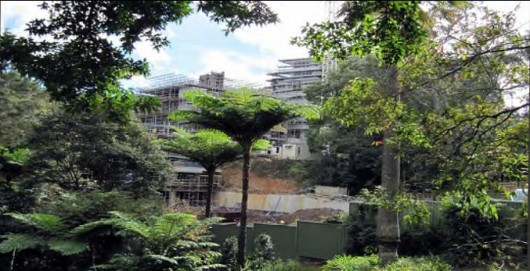 The disappearing urban forest of Ku-ring-gai, Sydney’s North Shore
Biodiversity-linkages within Urban Forest are provided by
connecting gardens, street trees, golf courses, ovals and parks. The disappearing urban forest of Ku-ring-gai, Sydney’s North Shore
Biodiversity-linkages within Urban Forest are provided by
connecting gardens, street trees, golf courses, ovals and parks.
All link together with surrounding protected reserves
to form corridors and habitat for remaining urban wild-life…..
.
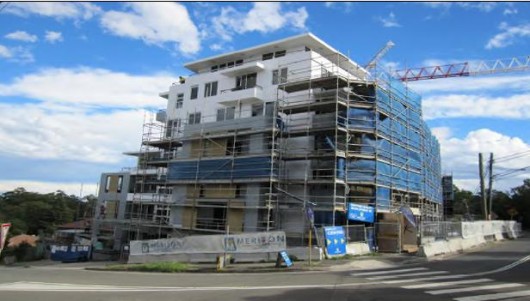 …however improper zoning allows biodiversity linkages to be lost
when land area and soils are cumulatively removed. …however improper zoning allows biodiversity linkages to be lost
when land area and soils are cumulatively removed.
By this process the regenerative capacity of native and nonnative Urban Forest vegetation
is displaced forever.
.
~ J. Harwood
.
Ku-ring-gai….’a community under the canopy’
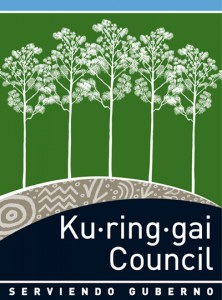
It is often said that the Ku-ring-gai community lives ‘under the canopy‘ because of the three large national parks and multitude of natural spaces in our local government area. To illustrate this idea, the Ku-ring-gai Council logo features a grouping of Sydney Blue Gums – a native tree prominent in the local landscape.
The five trees represent the five wards – Gordon, St Ives, Comenarra, Roseville and Wahroonga. The green typifies the Sydney Blue Gum and the band of blue above it depicts the bright sunlit sky which is visible through the swaying tree canopies.
The light brown graphic element below the trees acknowledges the area’s Aboriginal heritage. It includes indigenous symbols for a campsite, mountains, kangaroo, boomerang and emu provided by Aboriginal artist Nikki McCarthy. It also includes a pair of stingrays found in an Aboriginal rock carving in Ku-ring-gai Chase National Park, used in the logo to represent the Guringai people, sometimes known as ‘the stingray people’.
The black area at the bottom of the logo represents the understorey of the Sydney Blue Gum Forest as well as providing an important link to the traditional owners of the land by taking the same meaning as in the Aboriginal flag, with the black representing Aboriginal people.
The Ku-ring-gai Council motto, ‘serviendo guberno’, means ‘I govern by serving’ and has been used by Council since 1928. It is included in the logo to reaffirm Council’s fundamental commitment to serving the community.
[Source: Ku-ring-gai Council, ^http://www.kmc.nsw.gov.au/www/html/1881-council-logo.asp]
.
What is so special about Ku-ring-gai?
Ku-run-gai is an elevated region mostly wet sclerophyll forest ecology of high conservation value, including the endemic Blue Gum High Forest. The region is coming under relentless destruction for housing development and so its natural values are steadily disappearing.
‘Ku-ring-gai‘ derives its namesake from Mount Ku-ring-gai, a ridgeline about 200m above sea level, located about 30km north of the Sydney CBD. Apart from the ridgeline along which the Pacific Highway was built, Mount Kuring-gai consists of steep, heavily wooded hills and gorges. The water drains to the west into Berowra Creek and on the east into Cowan Creek. Both these waterways empty into the Hawkesbury River system. The area receives high rainfall, and its slopes fall steeply towards national parks on three sides – Lane Cove, Garigal and Ku-ring-gai Chase. Other natural features of Ku-ring-gai are its tree canopy (including important remnant Blue Gum High Forest, its wild life, its watercourses and its readily erodable soils.
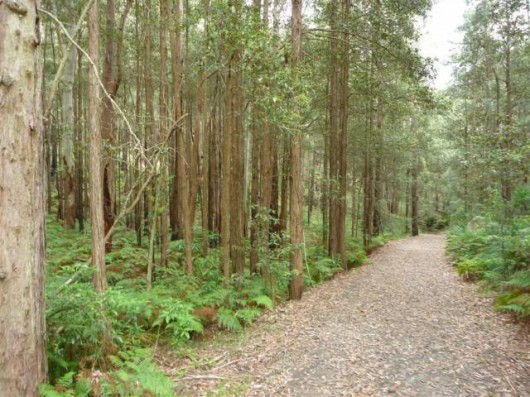 Blue Gum High Forest
Nearby Berowra Valley Regional Park
[Source: ^http://www.wildwalks.com/bushwalking-and-hiking-in-nsw/berowra-valley-regional-park/blue-gum-walk-joe-s-mountain-circuit.html]
Blue Gum High Forest
Nearby Berowra Valley Regional Park
[Source: ^http://www.wildwalks.com/bushwalking-and-hiking-in-nsw/berowra-valley-regional-park/blue-gum-walk-joe-s-mountain-circuit.html]
.
The Guringai Aboriginal people originally inhabited the area between the coast and Berowra Creek. Urgent changes are needed to the New South Wales Planning Act in order to prevent the loss of biodiversity and critical habitat and to consider the cumulative impacts in our future cities. ‘Ku-ring-gai‘ was an Aboriginal word describing the home or hunting ground of the local people, so this is possibly the origin of the name. Another suggested explanation for the name, that is now considered incorrect, was that kuringai was a combination of the words kuri, meaning ‘black duck’ and ngai, meaning ‘self’ (supposedly local people referring to themselves as black).
The township was called Kuring-gai from 1892, but the suburb’s name was changed to Mount Kuring-gai in 1933. The Shire of Ku-ring-gai was first constituted with six councillors in March 1906. Almost all of Ku-ring-gai was designated for residential development as opposed to commercial and industrial developments, and very few blocks of flats were permitted before 1940.
Ku-ring-gai is now engulfed within an encroaching suburbia locally branded as Sydney’s North Shore. The Ku-ring-gai Shire encompasses the suburbs of Roseville, Lindfield, Killara, Gordon, Pymble, Turramurra, Warrawee and Wahroonga, straddling the ridge that carries the railway from North Sydney to Hornsby; and St Ives, straddling Mona Vale Road as it heads towards the coast.
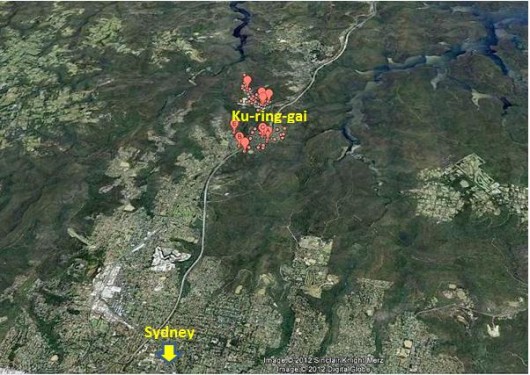 The relative position of Ku-ring-gai
on the northern outer tentacles of Sydney Metro sprawl
(Google Maps, 2012)
. The relative position of Ku-ring-gai
on the northern outer tentacles of Sydney Metro sprawl
(Google Maps, 2012)
.
Ku-ring-gai’s situation represents an example of insatiable corporate land use development being allowed to run roughshod over ecological values. Forested areas are being bulldozed, destroying remnant and critical corridors for flora and fauna. Ku-ring-gai contains urban forests of important biodiversity, yet regional government planning is being corrupted by wealthy developers and their wealthy lawyers to change laws to allow the bulldozers in. Remnant forest by remnant forest is being supplanted by high rise. The cumulative impacts on these critical habitats are un-reported tragedies.
[Sources: 2. ‘Mount Kuring-gai’, by Joan Rowland, 2011, in ‘Dictionary of Sydney’, Dictionary of Sydney Trust,^http://www.dictionaryofsydney.org/entry/mount_kuring-gai , 2. Ku-ring-gai Historical Society, 1996, ‘Focus on Ku-ring-gai: The Story of Ku-ring-gai”s Growth and Development’, ^http://www.kmc.nsw.gov.au/www/html/169-history-of-ku-ring-gai-council.asp ]
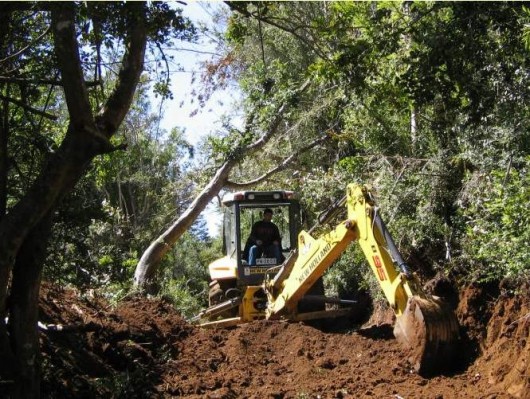 . .
Ku-ring-gai’s built heritage
..
Ku-ring-gai’s built heritage features some of the best in NSW – twenty-seven precincts were recommended by the National Trust in 1997 as Urban Conservation Areas. They include not only fine examples of Federation and Inter-war architecture, but many of these precincts display an overall quality and consistency that mark them out as being of State and National heritage significance.
.
Case in Point: ‘Tulkiyan House Museum’
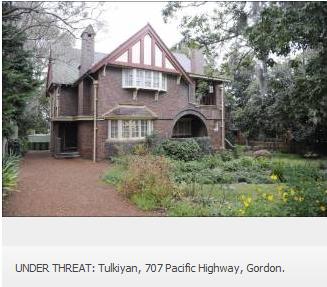
Built in 1913, Tulkiyan is an important example of the work of Bertrand J Waterhouse, a prominent Sydney architect. In Federations arts and crafts style, it displays asymmetrical, dominant gables; shingled roof and wall finishes; and bay windows. The interior includes elaborate plaster ceilings, Art Nouveau style gas fireplaces and built-in cupboards – an innovation at the time.
The Donaldson family lived in the house continuously for over 80 years from 1913, during which the original style was maintained. The home and its contents provide an insight into upper middle class life in Sydney during the first half of the 20th century.’
[Source: ‘Tulkiyan House Museum’, Ku-ring-gai Council, ^http://www.kmc.nsw.gov.au/www/html/1369-tulkiyan-house-museum.asp]
.
‘2009: Ku-ring-gai’s built heritage comes under threat of high rise’
[Source: ‘National Trust warns on Ku-ring-gai Planning Panel plan’, 20090814, by Katrina Adamski, North Shore Times, ^http://north-shore-times.whereilive.com.au/news/story/high-density-plans-ripping/]
.
THE heart of Ku-ring-gai is being ripped out with the possible demolition of 692 heritage homes.
This is the view of the National Trust, which has taken a stance against the Ku-ring-gai Planning Panel’s proposals to build medium- to high-density development in the area’s six town centres.
The trust’s core programs director Scott Woodcock said its members were trying to protect the natural and cultural heritage of Ku-ring-gai.
“The scale and magnitude of the threat to heritage buildings is unprecedented,” Mr Woodcock said. “The outrage is still prevalent in the community following the public meeting attended by 1000 people and more than 1800 submissions were received.
“At the National Trust, we are still receiving calls every day about what they can do to stop the Planning Minister (Kristina Keneally) from gazetting the plans. People have also been calling for us to organise a rally but we would prefer to speak to the minister first.”
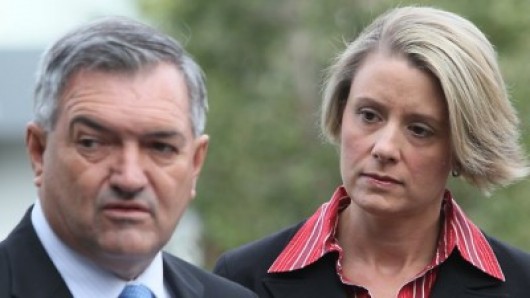 Kelly and Keneally
Pro-development NSW Labor planning ministers of yore
Sydney growthist lobby mantra – “Sydney must grow!” Kelly and Keneally
Pro-development NSW Labor planning ministers of yore
Sydney growthist lobby mantra – “Sydney must grow!”
.
Heritage buildings under threat of demolition in National Trust conservation areas include 1 Maclaurin Pde, Roseville; the Spanish mission-style church, 1186 Pacific Highway, Pymble; Tulkiyan 707 Pacific Highway, Gordon; and 2 Victoria St, Roseville.
The former Gordon home of Harbour Bridge designer John Bradfield could also be bulldozed under the proposal. Mr Woodcock said people were rightly concerned about losing their homes or having a six-storey development built next door to them.
“The spectacular P&O-style house at 1 Maclaurin Parade is not on the council’s heritage list or in a council conservation area,” he said. “It is within the trust’s urban conservation area, but even if it was individually saved, it would be surrounded by high-rise. The church and Tulkiyan are listed by the council, but even if they were kept they could be surrounded by high-rise which would destroy their curtilage. Practically the whole of Victoria St, Roseville, is under threat between Hill St and Spearman St. Only the school isn’t zoned for higher density’”
But Planning Minister Kristina Keneally said there was “no requirement” for the 700 heritage homes to be demolished. “The plan actually introduces heritage conservation zones,’’ Ms Keneally said. “In fact, the Bradfield house is proposed for heritage listing under the plan put forward to the department. “It is important to remember that these are people’s homes. It is up to an individual home owner as to what they do with their property.’‘
The minister said the government was identifying places, particularly around rail lines, where increased density and a different housing type could be accommodated.
Ms Keneally said only 6% of Ku-ring-gai was covered by the town centres plan.
.
Keneally in 2009 : “Sydney will grow and it will change …
it is projected to reach a population of about 6 million by 2036,
up by about 1.7 million people from 2006.”
.
But Opposition Leader Barry O’Farrell said almost 80% of Ku-ring-gai urban conservation areas would be destroyed under the State Government’s planning proposals. Mr O’Farrell said the National Trust report confirmed Labor’s statewide attack on heritage conservation.
“(Premier) Nathan Rees and (Planning Minister) Kristina Keneally are the Bonnie and Clyde of NSW, stealing the heritage heart out of the state,’’ he said. “These decisions are borne out of the inherent conflict of interest of a minister also being responsible for preservation of heritage items.’‘
He said the National Trust report was as close as you could get to a respected, independent umpire giving Labor a capital F for fail for its “lousy heritage credentials’”.
He said the NSW Liberal/Nationals had already committed, when in office, to appoint a separate heritage minister.
.
Local Reader’s Comments:
.
Denise Hendy writes (20090820):
.
“The ‘planning committee’ meeting at UTS was an insult to our intelligence. It was a total farce from a bulldozer panel committed to wrecking Ku-ring-gai’s leafy outlook. I have recently rejoined the National Trust because I feel they need support from locals to keep this Government on track.
I can’t believe the State Government is allowing our heritage to be torn down. Australia is a young country and has little heritage to show. Obviously these people have never been to visit old communites overseas to see the beauty and wonder of heritage which is important for younger generations to see and realise our history.”.
.
Graham Bode writes (20090815):
.
“Undoubtably it is a serious problem and with this government having two years to run it is just not going to get better. The government or its planning advisers have a view of Sydney as being something different to what it really is.
We should grow from where we are and where we have come from. Unfortunately neither the council or the state opposition are in the position to achieve a better outcome, to change the planning strategy.
As a writer to Saturday’s Sydney Morning Herald suggested a more vigorous but peaceful approach is required. Perhaps being a nuisance to the government and vigorous protesting may be the only options left open to us.”
.
The following article below ‘Mayday for Urban Forests‘ was contributed by Janet Harwood of the local community group ‘Friends of Ku-ring-gai Environment Inc.’ (FOKE)
.
Friends of Ku-ring-gai Environment

‘FOKE is a community group with membership drawn from across Ku-ring-gai, opposing inappropriate and unsympathetic overdevelopment within Ku-ring-gai, and defending and promoting the cultural and natural heritage of Ku-ring-gai.
‘FOKE is not anti-development. We work on behalf of residents and friends for the maintenance of Ku-ring-gai’s heritage and the enhancement of the existing traditional character and amenity of its environment, both built and natural.’
FOKE, PO Box 403, Killara, 2071, ^www.foke.org.au
.
‘Mayday for Urban Forests’
by Janet Harwood, FOKE (June 2011)
.
Urgent changes are needed to the New South Wales Planning Act in order to prevent the loss of biodiversity and critical habitat and to consider the cumulative impacts in our future cities. Biodiversity is critical infrastructure – the basis of life. Urban Forests and natural habitat remnants are the last biodiversity hotspots in cities. They are increasingly critical flora and fauna corridors. The significance of biodiversity to humans is greater than is understood. As humans seek health, well being and survival in future cities, cumulative impacts on these critical habitats are un-reported tragedies.
We are in ‘the urban age‘. The United Nations reports that more than half the world’s population lives in urban areas since 2007. (1) By 2050 it will be 70%. Australia’s urbanisation is higher. Scientists have long known human physical and mental health and well being depends on biodiversity. (2) As biodiversity decreases, human choices for survival shrink. (3) Scientists say its irreversibility makes biodiversity loss the most important issue faced by humanity (Dale and Hill 1996). Biodiversity loss is the most significant environmental problem facing Australia (Lindenmayer, “On Borrowed Time” 2007).
In his book ‘Collapse’ Diamond notes that removal of forests, and subsequent ‘landscape amnesia‘ and ‘creeping normalcy‘, play major roles in collapse of societies. (4) He points to policy makers for failure to perceive the problem of forest removal.
.
What is an ‘Urban Forest’?
.
An ‘Urban Forest‘ is existing biodiversity in protected reserves, as well as connected, but unprotected, native and non-native vegetation corridors in golf courses, public parks, ovals, residential streets and private gardens. Especially in environmentally sensitive areas, all linked natural habitat remnants, important seed-bank and sensitive soils, together, form part of precious Urban Forest.
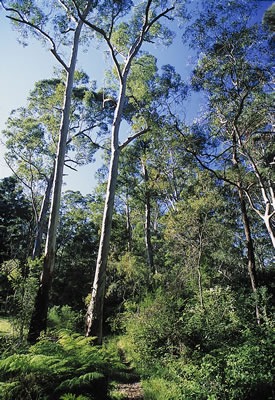 ‘Blue Gum High Forest’
in and around Ku-ring-gai ‘Blue Gum High Forest’
in and around Ku-ring-gai
.
Rare, urban biodiversity still exists in listed critically endangered ecological communities, part of Urban Forest within thirty rail minutes of the Sydney GPO – but for how long?
Urban Forest in Sydney occurs most densely in the north, north west of Sydney and also in southern and western Sydney. Rapid urbanization means biodiversity in the un-protected part of Urban Forest is vulnerable to zoning for development.
Due to the importance of biodiversity to human health in future cities, Urban Forest needs urgent protection, through legislation. (Ed: Biodiversity is also important for its own existence rights, beyond anthropocentric benefit).
Today, lands most desirable to protect have become the lands most likely to be developed. The word “biodiversity” appears seldom, if at all, in land-use planning policy platforms and legislation governing the planning of city futures. (5)
The absence of specific protective zoning for Urban Forest potentially means the application of ‘inner-city zoning‘ in unique ‘Environmentally Sensitive Areas‘ (ESAs). Unless urgent steps are taken for intergenerational equity in planning legislation including giving protection to Urban Forest by specific zoning, and requiring consideration of the cumulative impacts in zoning for development, we will almost certainly not have Urban Forest in the future.…however improper zoning allows biodiversity linkages to be lost when land area and soils are cumulatively removed.
By this process the regenerative capacity of native and non-native Urban Forest vegetation is displaced forever.
.
How do we know Urban Forest is disappearing?
.
Trees prevent development and their absence facilitates it. Cascading environmental damage commences at, or before, the point of zoning for development. Since each zoning and each development is assessed on its own, the un-assessed cumulative impact of zoning for development quickly turns an environmentally sensitive area (ESA) into a construction zone.
Zoning is the most profitable point in the development process. Zoning is also when the greatest damage is done to the environment.
‘Tree Preservation Orders‘ (TPOs) are of little value. Trees die mysteriously and are easily removed. Tree removal proliferates in dense, rare Urban Forest. Reliable tree record and protection of significant trees by local councils is lost. The domino effect of acquisition of properties for development, during zoning, is an insidious process. Most locals do not know when and where houses are acquired for development, which rapidly tears neighbours and neighbourhoods apart. (6)
As newer residents replace long-standing ones, ‘landscape amnesia‘ and ‘creeping normalcy‘ take over, and the once rich Urban Forest becomes an urban myth. Wildlife populations plummet and without habitat, urban biodiversity quickly disappears.
As the cumulative impacts of zoning increase and population pressures rise, tree removal gathers momentum. Golf courses, churches, schools and other institutions responding to these expansion pressures find the need to remove not one or two trees, but tens and hundreds of trees. This is in addition to tree removals by developers and individuals.
After development has occurred, the hundreds of saplings replanted in the remaining soils cannot replace habitat provided by foliage, branches and hollows of mature trees in an Urban Forest. In this way, environmentally uninformed decision making and cumulative zoning quickly destroys efforts, by council staff in the field and volunteers, to protect and restore biodiversity.
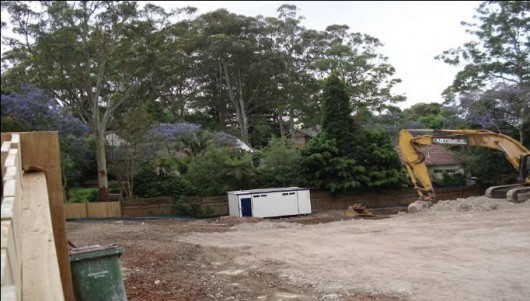 As sites are cumulatively cleared, the very basis for fragile Urban Forest
(i.e. rich soils and seed-bank)
is being excavated and removed forever by Improper Planning. As sites are cumulatively cleared, the very basis for fragile Urban Forest
(i.e. rich soils and seed-bank)
is being excavated and removed forever by Improper Planning.
.
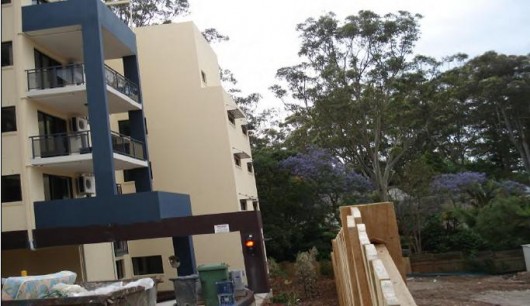 Replacement building side set-backs leave no room for tall canopy trees,
which once formed bio-links.
Improper Zoning permits a footprint totally inappropriate
for an Environmentally Sensitive Area (ESA) Replacement building side set-backs leave no room for tall canopy trees,
which once formed bio-links.
Improper Zoning permits a footprint totally inappropriate
for an Environmentally Sensitive Area (ESA)
.
The problem lies in the overarching power of land use planning legislation.
.
State (TSC Act)* and national (EPBC Act)* environmental legislation has failed to prevent biodiversity loss in NSW. The dominance of an ecologically un-informed NSW planning system, corrupted by failures, faults and flaws in that system, forces unreasonable concessions from environmental departments and regulatory bodies, resulting in irreparable biodiversity loss. (7).
The NSW planning system can implement zoning with negative impact where “critical habitat” provisions are not applied. Further, cumulative removal of vegetation and regenerative capacities (land area and soils) of Urban Forest is not assessed in land-use planning. A scientific study of cumulative impacts says, “while each single land use change results in a negligible impact, the accumulation of these individual changes over time and within a landscape or region may constitute a major impact.” (8) Neither state nor federal legislation considers the destructive effect of many zonings overlaying each other.
The NSW Government’s Standard Local Environment Plan (LEP) (Ed: bureaucratic one-size fits all planning) is full of unknown perils for an area of high biodiversity. Its ‘Standard Zoning‘ approach certainly will allow smaller blocks of land within the range of Urban Forest. It will allow more development in the very soils needing more protection, to maintain current biodiversity levels in irreplaceable Urban Forests. (9).
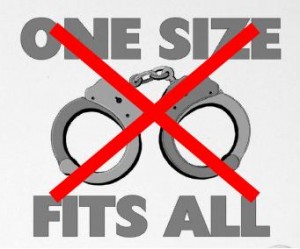
.
Urban Forest has far greater long term economic value than construction, which excavates and trucks away the very basis of fragile flora and fauna habitats – environmentally sensitive soils.
That the resulting real estate is now being sold overseas and to investors – makes zoning for development, in areas of rare Urban Forest, a highly questionable process.
.
The NSW planning system appears un-aware of the intrinsic value of, and the method and need for, protecting land for its delicate biodiversity. Clearly, a lack of understanding of the value of biodiversity is demonstrated by the nature and number of zonings allowed in environmentally sensitive areas (ESAs).
.
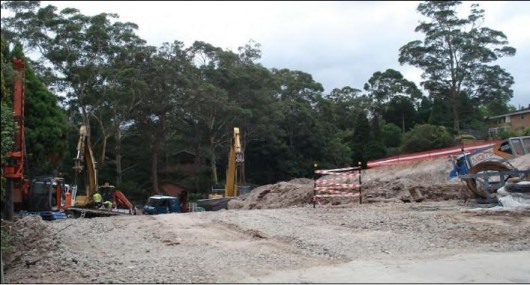 Blue Gum High Forest site damaged by “moonscaping” unassessed under one LEP.
Damage from an adjacent development is cumulatively allowed under another LEP. Blue Gum High Forest site damaged by “moonscaping” unassessed under one LEP.
Damage from an adjacent development is cumulatively allowed under another LEP.
.
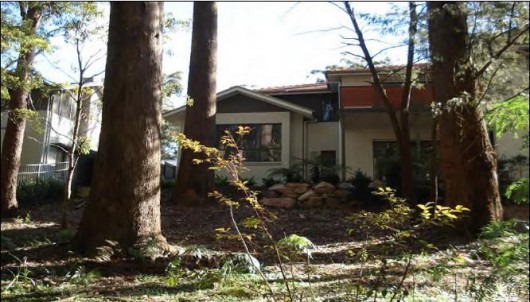 Building too close to established trees is the result of urban densification in Urban Forest.
The cumulative impact of inappropriate zoning is further tree removal. Building too close to established trees is the result of urban densification in Urban Forest.
The cumulative impact of inappropriate zoning is further tree removal.
.
Zoning for development is an un-recognized key threatening process for threatened species. The Planning legislation (EP & A Act)* genuinely fails to protect biodiversity. BioBanking (TSC Act) treats biodiversity protection as a financial transaction. The policy platform of the Planning Institute of Australia (PIA) fails to mention biodiversity. (10)
With little protection in legislation and policy, zonings for development have become key threats to rare, urban biodiversity.
In present land-use planning “sustainability” simply means catch-up, non-diverse sapling planting in remaining soils, after massive concrete footprints are made. Tellingly, a biodiversity strategy is not a gazetted instrument. It is not officially part of the land-use planning process, nor is it signed off by ministers, to precede the threatening process of zoning.
Media debate and public discourse of development in biodiversity rich areas. In the push to increase human population in Sydney’s North and North West, no media debate has been conducted regarding Urban Forest’s contribution to the Australian biodiversity pool in terms of the critically endangered ecological communities found in these areas. Yet Local Government Areas (LGAs) like Hornsby, Ku-ring-gai and Lane Cove are strategic wildlife corridors between national Parks. (11)
Examined in the media mainly in terms of dwelling numbers allocated and proposed, the unexamined attributes of Urban Forest are matters of national significance. A wealth of fauna and flora is being allowed to vanish now, from the creeping cumulative effects, of multiple zonings for development, on corridors of non-human habitat.
It is urgent to change land-use planning to protect precious urban biodiversity. Rather than displace our last Urban Forests, we should “bring forests into the cities”. (12)
City public lands, open-air carparks, railway corridors and vacant urban areas should be biodiversity refuges, community gardens and green spaces, to expand rare Urban Forest for human health. Local Council development planning directors are equipped to assess and report negative cumulative impact on Urban Forest. However, ecological qualification and direct responsibility, for biodiversity conservation and environment protection, are needed at director level. Policy makers and planners know that existing Urban Forest is easier to protect, than to re-forest. (13)
Urban Forests are crucial. In growing cities, once Urban Forests are removed and soils excavated, making amends is virtually impossible. Bio-links and rare urban biodiversity are of national importance and future job sources. The permanent loss of biodiversity (critical biological infrastructure) in Urban Forest is therefore a matter of national interest and security.
Storms, bushfires, droughts and flooding rains are removing flora and fauna habitats. (14)
Human development, inextricably tied to biodiversity, soils and Urban Forests, is also cumulatively removing the shared life support. (15)
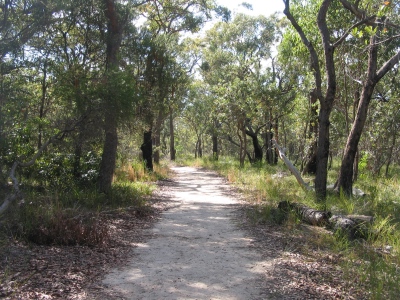 Mount Ku-ring-gai walking track Mount Ku-ring-gai walking track
.
Important Questions:
.
-
Why are Urban Forests being allowed to disappear?
-
Why are protective legislative provisions over-ridden?
-
Why is ‘critical habitat‘ not declared more rigorously?
-
Is biodiversity conservation a source of future employment?
-
Should Urban Forest areas be given a new category of protective rezoning?
.
by Janet Harwood, June 2011 (Edited).
janetsh@optusnet.com.au
‘Our Future is the Natural World’
.
* Abbreviations used above:
TSC Act: ‘The NSW Threatened Species Conservation Act 1995’
EPBC Act: ‘The Environment Protection and Biodiversity Conservation Act 1999, the Australian Government’s central environmental legislation’
EP & A Act: ‘The NSW Environmental Planning & Assessment Act 1979’
.
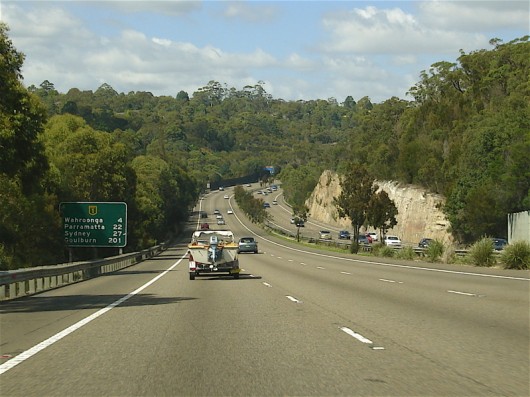 Six-lane freeway carved into Mount Ku-ring-gai Six-lane freeway carved into Mount Ku-ring-gai
.
‘Urban sprawl is ecological genocide – an inexcusable hate crime’
~ Editor
.
Notes and Further Reading:
.
1. UN-Habitat bi-annual State of World Cities report 2010, ^http://www.unhabitat.org/pmss/listItemDetails.aspx?publicationID=2917 (16mb)
(The United Nations Human Settlements Programme, UN-HABITAT, is the United Nations agency for human settlements. It is mandated by the UN General Assembly to promote socially and environmentally sustainable towns and cities with the goal of providing adequate shelter for all. Check website: ^http://www.unhabitat.org )
.
2. ‘Biodiversity Conservation: A Decision Making Context‘ (1996), book by Dr. Ann Dale and Prof. Stuart Hill
.
3. ‘Sustaining Life How Life depends on Biodiversity‘ (2008), book by Chivian E. and Bernstein A. (eds), Oxford University Press.
.
4. ‘Collapse How Societies Choose to Fail or Survive‘ (2005), book by Jared Diamond, Penguin Books.
.
5. See Policy platform of Planning Institute of Australia (PIA) and other urban projects and national urban policy.
.
6. See documentary film “State of Siege” in which activist film makers Dennis and Diane Grosvenor explore the destructive phenomenon of development and the politics behind it. ^http://www.imdb.com/title/tt0070959/
.
7. Standard Instrument (Local Environmental Plans) Order 2006, current version for 6 January 2012 to date, NSW Government legislation website, ^http://www.legislation.nsw.gov.au/maintop/view/inforce/epi+155+2006+cd+0+N
It is noted that NSW Environmental Zone protections available have failed to protect biodiversity and pressures from human development apply forcefully: when legislative provisions to declare “critical habitat” are not applied, where protective legislation is overridden; where cumulative impacts are not assessed; where systemic flaws and gaps continue to operate, biodiversity strategies are not given the status of gazetted instruments – and Departments of Environment are subsumed and/or not afforded the authorities they require, to genuinely protect biodiversity.
.
8. ‘Estimating the cumulative effects of development on wildlife habitat‘ (1998), book by David M. Theobald, James R. Miller and N. Thompson Hughes
.
9. ‘Environmental Baseline Study’ (2000), Ku-ring-gai Council website ^http://www.kmc.nsw.gov.au/www/html/212-research-studies-papers-and-reports.asp
.
10. Planning Institute of Australia website, ^http://www.planning.org.au/policy/policy-platform
.
11. Ku-ring-gai Council’s ‘Biodiversity Strategy‘, Appendix 6: Biodiversity Data, p.29, ^http://www.kmc.nsw.gov.au/resources/documents/Biodiversity_Strategy_May_2006_final_for_adoption1[1].pdf [>Read Document (1.1MB) ]
.
12. ‘Our Future is the Natural World‘, by J. Harwood, in a submission to ‘National Policy Unit Our Cities: Building a Productive, Sustainable and Livable Future’ 2011
.
13. Food and Agricultural Organisation of the United Nations (FAO), ^http://www.fao.org/docrep/005/t1680e/T1680E01.htm “Planning is important because trees are very often considered as an afterthought once development has taken place, rather than being incorporated at the original design phase. An integrated approach implies the participation of many different organizations – local councils, municipal and national planning bodies, departments, etc. Systematic management entails regulated tree management; operations such as planting, pruning, and felling must all be conducted in an organized manner, at the appropriate time. This is certainly more theoretical than actual in most urban settlements (in developed as well as developing countries); it also implies a greater degree of control over, or at least information about, all trees on all land types than usually exists.”
The FAO experience in ‘Urban Forestry‘ clearly indicates that more action is needed to protect existing Urban Forests (as defined). Zoning for protection of Biodiversity in Urban Forests (as defined), urgently needs to be specifically instituted through Planning legislation (EP&A Act). Local biodiversity strategies (TSC Act) need to be properly signed off by ministers and gazetted. Only the powerful land-use planning legislation can ensure that “critical habitat” in Urban Forests is not lost. Protective zoning for Urban Forest(as defined) and the complicating and devastating effects of un-assessed cumulative environmental impacts need to be immediately considered in Planning Legislation (EP&A Act).
.
14. ‘The Future of the Wild Radical Conservation for a Crowded World‘ (2006) book by J. Adams, Beacon Press, Boston, USA.
.
15. The basis for natural terrestrial habitats – Fertile soils:
“An estimated four million bacterial species occur in a ton of fertile soil, comprising ten billion or so organisms to each gram of weight. Although invisible, the collectivity of these organisms in soils and elsewhere is vital to our continued existence. Similarly, while a few thousands of the millions of insect species in the world afflict us as pests and disease carriers, we depend on the rest for our very lives. If beneficial insects did not flourish, most of the land ecosystems of the world would collapse and a good part of humanity would perish with them…….. For many reasons, not least our own well being, we need to take care of the rest of life”
by E. O. Wilson Foreword in the book ‘Sustaining Life How Life depends on Biodiversity‘ by Chivian E. and Bernstein A. eds. (2008) for The United Nations Programme.
.
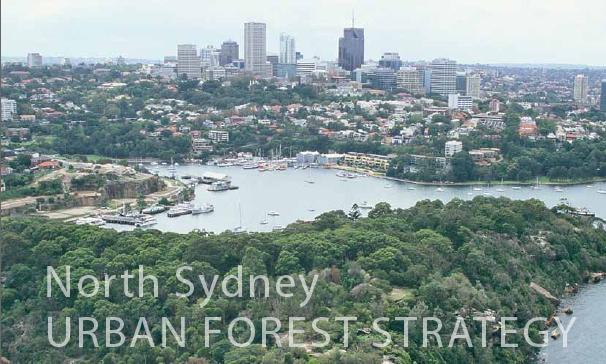 Urban Forest Strategy is a reality in nearby North Sydney Urban Forest Strategy is a reality in nearby North Sydney
.
Tags: biodiversity-linkage, Blue Gum High Forest, built heritage, creeping normalcy, critical habitat, Environmentally Sensitive Areas, FOKE, Friends of Ku-ring-gai Environment, Guringai Aboriginal, improper zoning, inner-city zoning, Ku-Ring-Gai, landscape amnesia, Mount Ku-ring-gai, overdevelopment, Standard Local Environment Plan, Standard Zoning, Sydney North Shore, the urban age, Tree Preservation Orders, Urban Conservation Areas, urban forest
Posted in Threats from Development | 1 Comment »
Add this post to Del.icio.us - Digg
Leave a Reply
You must be logged in to post a comment.
February 16th, 2012
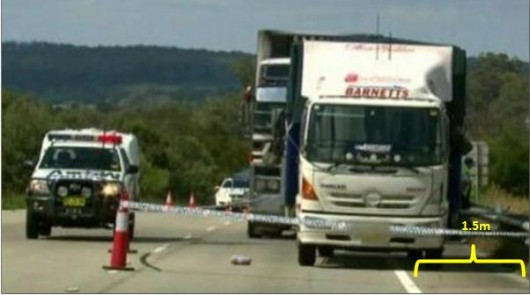 Freeway’s narrow shoulders – obvious death traps Freeway’s narrow shoulders – obvious death traps
Site of another truck killing – this time the Hume Freeway near the Bowral turnoff, New South Wales
.
Another week, another truck “cleaning up people” on trucking expressways. Expressways with more and faster trucks are more dangerous.
.
Not an unusual breakdown:
.
A young woman travelling south in her car along the Hume Freeway suddenly experiences her car overheating on the Southern Highlands section. The woman rightly pulls over into the left service lane (‘freeway shoulder‘) and she rightly calls the NRMA roadside breakdown service for mechanical assistance.
The NRMA rightly attends the breakdown incident and the mechanic arranges for a vehicle tow. The NRMA subcontracts the tow operation out to local Mittagong-based tow truck operator, Highlander Towing. Owner-operator, Geoffrey Clark, rightly attends with his vehicle tray truck and parks in front of the woman’s car in the service lane. At this section of the Hume, the freeway shoulder is substandard in width and so the towing operation protrudes into the outside freeway lane. The breakdown location is later confirmed by attending police that it was situated on a long straight section of the Hume having a good 500 metre visibility to south approaching traffic.
The tow truck had been tipped in readiness to pull the broken down car on to its tray just before the accident. It is believed Mr Clark and the woman were standing on the roadside of their parked vehicles when a southbound truck struck both Geoffrey and the woman at freeway speed. It is about 12:40pm (midday on a clear day). Both Mr Clarke and the still unidentified young woman died at the scene.
Crash investigators were last night trying to work out how the truck failed to see the woman’s maroon-coloured car and Mr Clark’s truck on the side of the road. It is branded a ‘double fatality’. Traffic is stopped causing congestion. Police and paramedics attend, and the scene is assessed for the coroner.
These two people just going about their normal business suddenly and wrongly have become road ‘statistics’. Statistics for the authorities to collate and report.
.
‘Police said the truck literally cleaned up the two people’
~ The Daily Telegraph (Sydney).
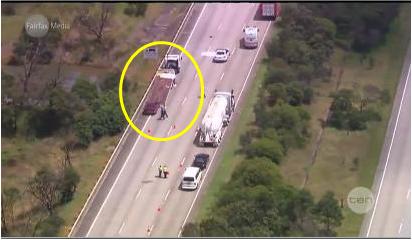
“What chance would anyone have when a truck doing at least 100 kph comes at them?” a police spokesman said.
Yes, roads are dangerous, fast freeways moreso. Cars kill, but trucks kill more easily offering less chance of survival for other road users. When a shoulder on a six laned interstate freeway is designed too narrow to allow safe clearance from high speed traffic, that freeway shoulder is surely a death trap waiting to happen.
Breakdowns beware? If a vehicle breaks down it is involuntary. A driver does not have a choice of continuing on until there is a safe place to pull over, since the vehicle won’t go.
.
The truck killing of two pedestrians is reported to have been horrific. Geoffrey Clark was aged in his 40s and reportedly a father of four. The media have not yet reported the family circumstances of the young woman at the time of publishing today.
 Ave atque vale Geoffrey Clark,
Tow Truck Operator, father-of-four,
and the unidentified standed woman motorist who Geoff dutifully went to assist
(I write that your passings not be in vain) Ave atque vale Geoffrey Clark,
Tow Truck Operator, father-of-four,
and the unidentified standed woman motorist who Geoff dutifully went to assist
(I write that your passings not be in vain)
.
According to media reports, Geoffrey Clark, every time a stranded motorist would call him for help, Geoffrey Clark would drop everything and race to their aid. The tow truck company owner and father-of-four was doing exactly that yesterday when he and a female motorist he was helping were run down and killed instantly.
Mr Clark, who operated Highlander Towing, was attending to a broken down Ford sedan in a lane of the Hume Freeway at Mittagong in New South Wales when he was hit by a truck.
The truck driver, from Barnetts courier company (see previous photo of truck ), was taken to hospital with shock.
Distraught employees and friends last night said Mr Clark was a “one in a million” boss who never said no.
“He’d happily go out to help someone in the middle of the night, that’s Geoff,” one employee said. “He was always ready to help, no matter who they were.”
.
Highlander Towing – customer testimonies
‘Prompt and Friendly Service’
(posted by Mun Lum at Tuesday 26 April 2011)
“Our car broke down in Robertson and the company (NRMA recommended) came out fairly promptly and was very helpful in providing advice on where the car can be towed to and repaired. It was over the Easter long weekend and the workshop was not open so they offered to store it at their place until the workshop opened. Great and friendly service. Thoroughly recommended.”
.
‘Highlander Towing’
(posted by Anonymous User at Thursday 30 April 2009)
“Great blokes, Great Service, Highly Recommended”
.
‘Highlander Towing’
(posted by R Maclean at Sunday 18 February 2007)
“I got stranded at Sutton Forest having hit a wombat and my car had to be towed. The guys at Highlander were great – they arrived quickly, stored the car in their warehouse and found me a motel at 1.30 am (all in a black out in Mittagong). The next day they arranged for the car to be trucked to Sydney and I caught a lift with the car. The two guys I encountered were nice blokes (Ray and John) – as a lone female I was a little anxious about who was going to turn up at midnight. I needn’t have worried – Ray who went out of his way to be helpful. Thanks for the help guys, it is much appreciated.”
.
It was the same fatal stretch of the freeway, which last month claimed the lives of three members of the Logan family in another tragic truck accident.
.
RTA meets budget by skimping on safe freeway shoulders
.
RTA’s Budget Shoulder Contingency
.
The pattern of cost blowouts by the RTA’s Major Infrastructure projects must be legion. Its failure to factor in inclement weather contingency and the poor operational management of subcontractors are typical excuses for its record of material cost overruns. But the RTA has long relied upon an internal engineering contingency that enables it to meet the external budget irrespectively.
It works like this – over the lineal distance of a major freeway upgrade project, every metre of widening costs millions. The multiplier effect of highway/freeway/expressway construction is considerable for every inch that is made wider. Freeway shoulders represent the extremes of that widening.
So over an entire project if the freeway shoulder width is trimmed, total project costs can be reduced substantially. So when vague budget cost estimates show signs of blowing out, such freeway shoulders are the contingency that are trimmed in width and thus cost. And who’s going to notice outside RTA internal design engineering?
Voila! Project on budget and management bonuses paid thank you very much. But tell that to the families of the two innocent people mentioned above who were yesterday using the RTA’s ‘high standard’ interstate six-laned dual carriage Hume Freeway.
.
Narrow freeway shoulders are designed death traps
.
But the narrowing of freeway shoulders may save money but compromises safety. Given that standard truck width is 2.5 metres, all freeway shoulders that are gazetted as designated truck routes for safety reasons need to be designed with at width to safety accommodate a truck of 2.5 metres in width.
The Hume Freeway is one of Australia’s major inter-city highways, running for 880 km between Sydney and Melbourne. It is part of the Auslink National Network and is a vital link for road freight to transport goods to and from the two cities as well as serving Albury-Wodonga and Canberra. At this section through the New Spouth Wales Southern Highlands, the Hume is a six-laned dual carriageway freeway not a highway, which permits a speed limit of 110kpm, it demands a higher standard of safety design. There needs to be an added margin of clearance between a stationary vehicle parked on a freeway shoulder and the traffic including trucks doing 110kph.
Clearly, freeway shoulders on such high speed routes need to have a minimum safety width greater than 2.5 metres.
The RTA (TRMS) is responsible for providing safe freeways to the travelling public and so the RTA the owes all freeway users a general duty of care out of its freeway design including the provision of a safe freeway shoulders. The RTA exercises control over the Hume Freeway, is responsible for its design including adequate freeway shoulders.
In this case of the tragic deaths of the two people on the Hume Freeway yesterday, the RTA has breached that duty of care by providing an unsafe freeway shoulder both from an occupational perspective in the case of the tow truck operator performing a breakdown operation, as well as to freeway users in general. The narrow 1.5 metre freeway shoulder created an obvious and unacceptible danger for any vehicle parked on it that measured over 1.5 metres in width, such as the tow truck (at closer to 2.5 metres in length).
It was the same fatal stretch of the freeway which last month claimed the lives of three members of the Logan family in another tragic truck accident.
 Great Western Expressway
…the Liberal-Labor Government’s Trucking Expressway Vision for the Blue Mountains
(Note the narrow shoulders)
Great Western Expressway
…the Liberal-Labor Government’s Trucking Expressway Vision for the Blue Mountains
(Note the narrow shoulders)
.
The Trucking Expressway Vision – a legacy of Bob Debus MP
.
- Perpetual Four Lanes dividing Blue Mountains communities
- Narrow Shoulder Death Traps
- Unmonitored Continuous 80kph, so nudging 90kph
- Anti-Pedestrian, anti-Schools through towns and villages
- Anti-Wildlife through so-called ‘World Heritage’
- All for bigger, longer, faster trucks and more of them
.
March 2011: Truck hit and run of pedestrian on F3 Freeway
.
A year ago police were called to investigate the discovery of human remains thought to be those of a male on the F3 Freeway near Somersby on the NSW central coast.
On 1st March 2011, human body parts were found strewn across two lanes in what police suspected of a truck hit and run accident. Police were reported searching the area near the Gosford off-ramp north of Sydney, after a motorist reported the gruesome find about 11.45pm near midnight.
.
Revelations: 1990 ‘NSW Heavy Vehicle Crash Study’ by Monash University
.
In 1990, the Australian Federal Office of Road Safety (Canberra) together with the New South Wales Safety Bureau commissioned a study to examine the cause of crashes involving heavy vehicles in New South Wales between 1988-89 and to suggest countermeasures.
In summary, the findings of the study by the Monash University Accident Research Centre in 1990 found that factors that contributed to producing a severe truck crash environment in NSW included undivided highways of poor standard (including narrow shoulders). The study’s recommended counter-measures from the study included road improvements (at blackspots, delineation, road shoulders, culvert protection).
Read ‘NSW Heavy Vehicle Crash Study Final Technical Report‘. (File size: 14MB)
.
NSW Government culpability questions to answer:
.
- What recommendations of the 1990 Monash Report did the RTA implement and where, and not implement and where?
- Why does Australia’s possibly busiest national truck route, the Hume, have substandard freeway shoulder widths to allow for a standard truck, let alone allow for a width of necessary safety margin to separate high speed traffic and breakdown vehicles parked in the shoulder?
- What is the RTA’s standard procedure for addressing vehicle breakdowns on the Hume, notably along the Southern Highlands section of the Hume?
- If standard procedure was followed in this case by both the NRMA and the towing company, how is the NSW RTA (NSW Transport Road and Marine Services) not liable for breaching its public duty of care and contributing to the tragic deaths of these two freeway users going about their ordinary business?
.
Footnote
.
‘Families praise pair killed in highway tragedy’
[Source: ‘Families praise pair killed in highway tragedy’, by Lisa Davies, Sydney Morning Herald, 20120217, p.6.^ http://www.smh.com.au/nsw/families-praise-pair-killed-in-highway-tragedy-20120216-1tbtf.html]
.
‘A tow truck driver and a woman whose car had broken down on the side of the Hume Highway near Mittagong were killed by a passing truck, Wednesday.
Sarah Frazer was finally about to fulfil her dream, which was to study in pursuit of her great passion – photography.
”My car is pretty much all packed up except for my bedlinen and a few loose ends,” the 23-year-old wrote to her aunt on a Facebook page.
But less than 24 hours later, not long after she started out on her ”newest adventure”, she was killed on her way to university in Wagga Wagga. Her faithful car, brimming with her possessions, had failed her when she needed it most, breaking down along the way. Ms Frazer and the man who came to her aid on the Hume Highway were both killed instantly on Wednesday when a truck failed to see them until it was too late. A tow-truck driver and well regarded southern highlands local, Geoff Clark, had rushed to Ms Frazer’s aid when her car broke down on a narrow stretch of the highway, about two kilometres from Mittagong.
Her car could fit only partly in the road’s shoulder, and the two were trying to prepare it for towing. It is believed the truck driver may simply have seen the two vehicles too late.
Ms Frazer, from Springwood in the Blue Mountains and a former student at St Columba’s High School, was described yesterday as ”a truly amazing person”.
”A world traveller, fearless, funny, kind, strong willed, bright and beautiful,” her aunt Kristina wrote on Facebook.
”She was my niece and my friend. I will miss her terribly.”
Another relative described his family’s grief on such a ”very sad day”, saying his ”beautiful, intelligent cousin” had died ”on her way to start a new life” at university.
Police are investigating the crash and the truck driver is assisting with inquiries. The driver was treated for shock at Bowral Hospital.
Mr Clark, a father of four young boys aged 8 to 14, was hailed as a good Samaritan for stopping on the dangerous strip of the highway and volunteering to drive Ms Frazer to Wagga Wagga.
Inspector Mark Wall, from Bowral police, who knew Mr Clark, said he was ”a hard worker and a good bloke”. He had been a truck driver for most of his life before starting his own towing business eight years ago. His widow, Sam, told reporters: ”He was a very caring husband. Thoughtful, just the best really … he did all that he could do to be safe.”
 Sarah Frazer
Ed: Too young. It is not right. Our highways and freeways need to be safer. Sarah Frazer
Ed: Too young. It is not right. Our highways and freeways need to be safer.
.
References
.
[1] ‘ Two killed as truck hits breakdown operation on highway‘, by Alicia Wood, 20120215, ^ http://www.smh.com.au/nsw/two-killed-as-truck-hits-breakdown-operation-on-highway-20120215-1t5lm.html
.
[2] ‘ Two killed in Hume Highway tragedy near Mittagong‘, by Clementine Cuneo, Police Reporter, The Daily Telegraph, 20120215, ^ http://www.dailytelegraph.com.au/news/sydney-nsw/two-killed-in-hume-hwy-smash/story-fnb5f12x-1226271751142
.
[3] ‘ Two killed in crash near Mittagong‘, SkyNews, 20120215, ^ http://www.skynews.com.au/national/article.aspx?id=718772&vId=
.
[4] ‘ Man dies on road as he came to woman’s rescue‘, The Daily Telegraph, 20120216, ^ http://www.news.com.au/national/man-dies-on-road-as-he-came-to-womans-rescue/story-e6frfkvr-1226272184058
.
[5] Highlander Towing Pty Limited, ^ http://www.thesouthernhighlands.com.au/directory/travel/couriers/highlander-towing
.
[6] ‘ Human remains scattered on F3: police suspect hit and run‘, by Stephanie Gardiner, 20110302, ^ http://www.smh.com.au/nsw/human-remains-scattered-on-f3-police-suspect-hit-and-run-20110302-1bdjb.html
.
[7] ‘ Heavy Vehicle Crash Study Final Technical Report‘, Monash, ^ http://www.monash.edu.au/miri/research/reports/atsb092.pdf
.
Leave a Reply
You must be logged in to post a comment.
February 14th, 2012
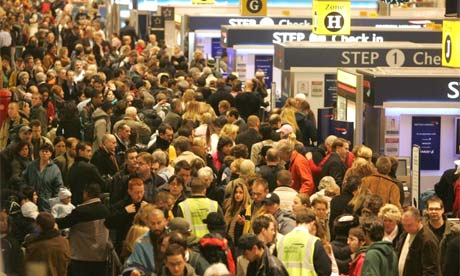 This is a UK International Airport This is a UK International Airport
Such crowding makes humanity a commodity, so wrongly destructive,
but then the British Government has reneged public transport accountability to Walker Guidelines.
Australia seems hell bent on trying to become more like overpopulated countries.
Why? The selfish guise of ‘economic growth’ by those who stand to financially benefit at others expense
.
Shortsighted ‘Airport Gate Immigration‘ ignores the triple bottom line cost of ‘Fully Settled Immigration‘ into any country.
What I mean by this is that the Growthist Lobby’s open door encouragement of immigration just to the airport, simplistically views a one-sided benefit – that more foreigners immigrating can only positively bring more foreign dollars and so add economic demand by numbers to a host nation. But it is as simplistic a view. A tour operator seeing tourists arrive and seeing them as tour revenue – only revenue, no cost.
But immigration is not tourism. Immigrants stay forever. Unlike tourism, immigrants represent not just revenue, but cost – Triple Bottom Line cost – a phrase that has been little used since the 1980s. ‘Sustainability‘ is more euphemistically malleable.
The economic, social and ecologial costs of immigration are selectively ignored by growthists, particularly government short-termism which just looks as quick fix employment – aka 457 Work Visas for the mining industry, too mean to invest in training the local population. Meanwhile corporate miner profits are at record levels. The banks are making a killing with more mortgage loans and their profits are soaring.
 ANZ Bank’s new brand represents a bank “for the people” ANZ Bank’s new brand represents a bank “for the people”
The new logo has a central human shape representing ‘customers and staff’.
The marketing cost is $15 million to roll-out with the tagline “We live in your world”
Meanwhile, ANZ this month has sacked 1000 of its employees, and raised its mortgage rates, selfishly ignoring Australia’s Reserve Bank policy
All Australia’s greedy four big profit banks are set to sack 10,000 over the next year or so.
And 457 Work Visas keep being handed out to foreigners.
ANZ has become only for its CEO and its selfish shareholders.
.
National government economic numbers look good because demand is up with its multiplier effect on consumer demand, housing demand and numbers employed. But it twists the definition of unemployment. It conveniently ignores the society and liveability metrics and ecological health indicators – these are worsening.
So ‘Airport Gate Immigration‘ has these hoards arriving. Australia’s Immigration Department handballs all the costs to the states and urban local governments, where most of these immigrants mainly end up settling. ‘Migration to Australia has the potential to alter population dynamics, within and across cities and regions. In practice, almost 90% of new migrants settle in cities.” [Source: Department of Immigration and Citizenship (DIAC) 2010].
‘The population projections affirm the dominance of our largest two cities, Sydney and Melbourne, which are projected to each nudge seven million people at mid century and the very significant growth anticipated for both Brisbane and Perth, which are each expected to more than double in size over this period.’
[Source: ‘Contemporary Urban Australia’, Australian Government – Infrastructure Australia, ^http://www.infrastructure.gov.au/infrastructure/mcu/files/NUPBP_Ch3_Contemporary.pdf]
.
Look at the statistics for Melbourne, Sydney, Brisbane and Perth – the main destinations of choice by most immigrants into Australia by far.
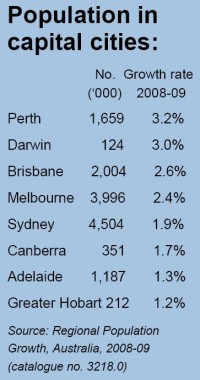 . .
SYDNEY: “With a population that is expected to reach around 9 million by the year 2031, NSW will require additional housing, more jobs and a host of critical infrastructure to meet demand. Meeting the transport demands of that growing population is one of the biggest challenges facing NSW.”
[Source: New South Wales Government, 2011, Transport for NSW, ^http://haveyoursay.nsw.gov.au/faq/index/21]
.
BRISBANE: “Brisbane’s Lord Mayor says the city could support significant population growth if more investment was made in infrastructure and services.”
[Source: ‘Brisbane’s infrastructure can’t support growth: mayor’, ABC News, 20100722, ^http://www.abc.net.au/news/2010-07-22/brisbanes-infrastructure-cant-support-growth-mayor/915594]
.
MELBOURNE: ‘Melbourne Lord Mayor Robert Doyle said population growth within the capital cities was a big challenge to infrastructure and planning.’
[Source: ‘Population growth challenges capital cities’, by Stephen Lunn, social affairs writer, The Australian, 20100614, ^http://www.theaustralian.com.au/news/nation/population-growth-challenges-capital-cities/story-e6frg6nf-1225879194354]
.
PERTH: ‘Royal Automobile Club head of member advocacy Matt Brown says Perth’s road network is stretched and in need of urgent attention. “There is clear evidence that our road system is under considerable stress and it is struggling to cope with the traffic we already have, and with the population growing rapidly, these problems are going to get worse,” he said. “Perth’s freeways and highways are becoming carparks at rush hour and this is only going to get worse. Creating a better and more accessible public transport system is just one way to help solve the issue of congestion.’
[Source: ‘Traffic congestion adding to city’s growing pains’, by Kent Acott and Geoffrey Thomas, The West Australian, 20010124, ^http://au.news.yahoo.com/thewest/a/-/latest/8699963/traffic-congestion-adding-to-citys-growing-pains/]
.
.
And so in these places social and governent infrastructure has exceeed capacity – road congestion, public transport congestion, hospital waiting lists, propert demand is through the roof (which contiunues to make growthist property developers richer).
 Past PM Kevin Rudd and his infamous ‘Big Australia Mein Kampf’:
…”I actually believe in a big Australia I make no apology for that. I actually think it’s good news that our population is growing”
The Labor national government still is pushing for Australia to have more than 35 million people by 2050. Past PM Kevin Rudd and his infamous ‘Big Australia Mein Kampf’:
…”I actually believe in a big Australia I make no apology for that. I actually think it’s good news that our population is growing”
The Labor national government still is pushing for Australia to have more than 35 million people by 2050.
.
Australia’s public utilities are overloaded (water, electricity, public transport, roads) and so major capital investment is being undertaken, robbing treasury resources away from locals who have long funded government coffers from decades of paying taxes. So the taxes now go into multi-billion dollar desalination plants in these cities. Electricity transmission infrastructure can’t cope with the population increases in Australia’s major capital cities. Traffic congestion is undermining Australian traditional lifestyles as more people have to dedicated more of their day commuting. The Australian Dream – owing a quarter acre block, has all but disappeared and now some growthists even curse it as a folly. Escaping to the backyard is now denied to most young Australians.
Try getting a job and see the queues!
Try finding affordable child care in an Australian capital city!
Try renting a flat in an Australian capital city!
Try buying a house in these cities where one’s parents live and like one’s parents once could. Children reaching adult age are forced to more away from their parents to more affordable areas, often to the country and interstate. Immigrant demand for urban housing is segregating established local families. The children are forced to move out of the cities their grew up in.
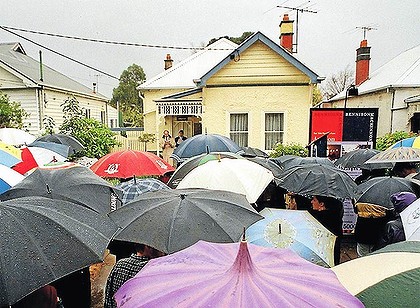 A typical Melbourne real estate auction
The beneficiaries of high property values are the wealthy
and the banks who suck massive mortages foir life out of stretched family incomes A typical Melbourne real estate auction
The beneficiaries of high property values are the wealthy
and the banks who suck massive mortages foir life out of stretched family incomes
.
Demand for housing is ruining urban amenity as more high-rise towers become imposed upon established locals. When new housing is built, the necessary public infrastructure is ignored by both the developer and national government – no new schools, child care, public transport, hospitals, etc. Local and state governments are unfairly expected to absorb the cost burden. Housing demand is also driving urban sprawl which is destroying arable land for vital food production. Sprawl is bulldozing ecology and reducing vital remnant habitat into smaller islands, with more species closer to the brink of extinction.
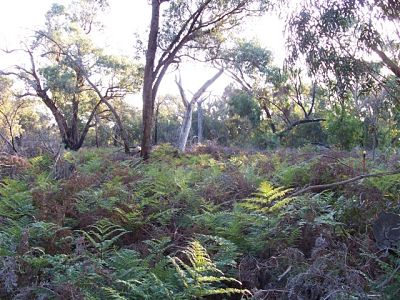 Coomoora Woodland
In outer Melbourne’s Keysborough this important ecology is threatened by urban sprawl
Ecology has no voice, no union, no political representation – because like all ecology before,
it is denied a right to exist, to have a say, to vote…like human slaves before.
(Photo by Damon Anderson) Coomoora Woodland
In outer Melbourne’s Keysborough this important ecology is threatened by urban sprawl
Ecology has no voice, no union, no political representation – because like all ecology before,
it is denied a right to exist, to have a say, to vote…like human slaves before.
(Photo by Damon Anderson)
.
‘Airport Gate Immigration‘ is like burning down you house to keep warm, or eating you arm off because you’re hungry. Traditional Australia is seeing death by a thousand immigrants.
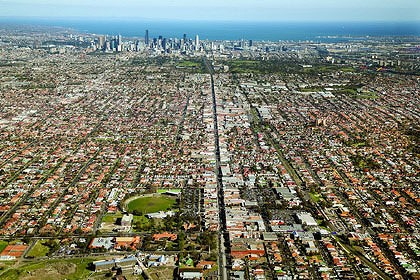 ‘Marvelous Melbourne’ it used to be called
Now its Mega Melbourne – quantity sucking out the quality ‘Marvelous Melbourne’ it used to be called
Now its Mega Melbourne – quantity sucking out the quality
.
‘Fully Settled Immigration‘ on the other hand, is about the full accommodating of immigrants until their are fully settled into their new country. They have work, a home, education, and have happily integrated into Australian society. Fully Settled Immigration respects the full needs and full costs of immigrants, rather than saying: ‘ok, your own‘ as one exits the international airport for the city.
In Australia, history since World War II has shown integration generally takes at least two generations. This is a realistic timeframe for Australian Govermment’s immigration responsibility and accountability.
It is time for a moratorium on all immigration until the full settled cost of immigration is known, made public and accepted by the Australian national government and the Australian people. It necessitates nationalising all transport, housing, education, health and all the demands of immigrants in order to alleviate the immigrant cost burden from overstretched state and local governments. The growthist industries need to pay their way too with appropriate infrastructure levies and employment training levies for each on an immigrant per capita basis.
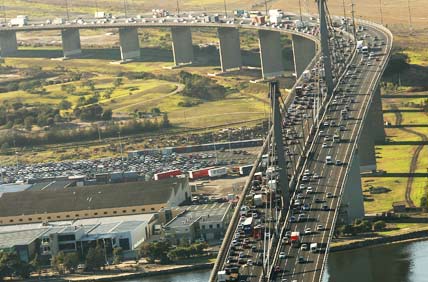 Melbourne’s Westgate Bridge
Now even the four-lanes can’t cope
Developers and governments keep building more sprawl in the west
Count the buses. Where’s the bus lane? Melbourne’s Westgate Bridge
Now even the four-lanes can’t cope
Developers and governments keep building more sprawl in the west
Count the buses. Where’s the bus lane?
.
Take the regional Victorian township of Alexandra with its 12,000 residents for instance. For every 12,000 immigrants, the national goverment needs to replicate the same infrastructure that Alexandra enjoys in order to maining Australian social standards. But it needs to do this with no ecological footprint, because ecology is already disappearing with the 26 million already insatiable humans here.
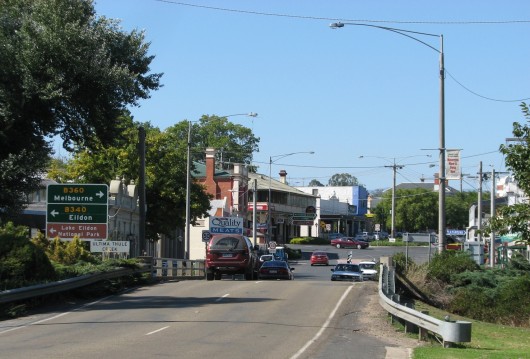 Victoria’s regional township of Alexandra
An Australian triple bottom line urban design standard
(click photo to enlarge) Victoria’s regional township of Alexandra
An Australian triple bottom line urban design standard
(click photo to enlarge)
.
Further Reading:
.
[1] ‘ Can An Immigrant Logically Oppose Immigration?‘, by ‘Tim, 20120214,^ http://candobetter.net/node/2777
.
[2] ‘ We can keep our leafy suburbs and still save the planet‘, 20091122,^ http://www.theage.com.au/opinion/society-and-culture/we-can-keep-our-leafy-suburbs-and-still-save-the-planet-20091122-isqz.html
.
[3] ‘ Rudd welcomes big australia‘, 20091023, ^http://www.abc.net.au/news/2009-10-23/rudd-welcomes-big-australia/1113752
.
[4] ‘ The Cars that Ate Melbourne‘, by Friend of the Earth Melbourne, ^ http://www.melbourne.foe.org.au/?q=sc/the_issues
.
[5] ‘ New brand and logo to cost ANZ 15 million‘, ^ http://www.news.com.au/business/new-brand-and-logo-to-cost-anz-15-million/story-e6frfm1i-1225790269154
.
[6] ‘ ANZ cuts substantial number of jobs in Melbourne‘, Herald Sun, 20120213, ^ http://www.heraldsun.com.au/business/anz-cuts-substantial-number-of-jobs-in-melbourne/story-fn7j19iv-1226269646858
.
[7] ‘ The Impact of Mass Immigration on Canadian and Global Overpopulation‘, Marvellous Melbourne.org, ^ http://marvellousmelbourne.org/drupal/?q=node/1205
.
[8] ‘ Carrying capacity: can a big country with very few people be overpopulated? – Currents‘, by Phoebe Hall, The Environment Magazine, Mar-Apr 2003, via ‘Find Articles, ^ http://findarticles.com/p/articles/mi_m1594/is_2_14/ai_98469934/
.
[9] CanDoBetter.net Immigration articles, ^ http://candobetter.net/immigration
.
[10] CanDoBetter.net Overpopulation articles, ^ http://candobetter.net/taxonomy/term/134
.
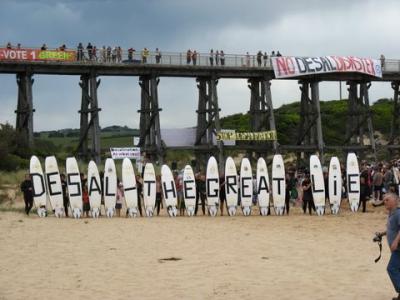 Melbourne’s growing water supply for uncontrolled immigrants inflicted upon local country residents of coastal Wonthaggi. Melbourne’s growing water supply for uncontrolled immigrants inflicted upon local country residents of coastal Wonthaggi.
This has been forcibly paid for by decades of Melbourne local taxpayers.
They stand to benefit nothing but cop population invasion from foreigners and government legislated destruction of Australian valued amenity.
This is the epitome of treason.
Yet Australia’s Liberal-Labor alternating time-swap governments say to Australians: cop it sweet, you are a tolerant society so be tolerant!
.
Tigerquoll
Suggan Buggan
Snowy River Region
Victoria 3885
Australia
.
Tags: 457 Work Visas, 730 Report, airport gate immigration, Alexandra, ANZ Bank, Australia to have more than 35 million people by 2050, Australian Dream, Big Australia Mein Kampf, Coomoora Woodland, Desalination Plant, fully settled immigration, growthism, growthist lobby, I actually believe in a big Australia, immigration, Kevin Rudd, Kevin Rudd's Big Austraia, Melbourne sprawl, overpopulation, quarter acre block, Rudd's Big Australia Manifesto, triple bottom line, Wonthaggi, Wonthaggi Desal Plant
Posted in Threats from Overpopulation | No Comments »
Add this post to Del.icio.us - Digg
Leave a Reply
You must be logged in to post a comment.
February 11th, 2012
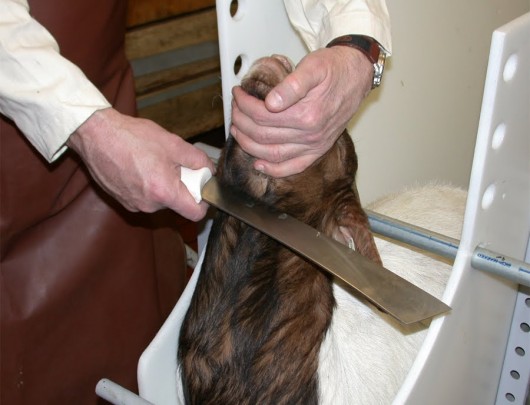 Halal Religious Slaughter
..requires throat slitting with a steel knife
. Halal Religious Slaughter
..requires throat slitting with a steel knife
.
The conditions required for ‘halal slaughter‘ require no stunning, instead death is executed manually using a steel knife, irrespective of the consciousness of the victim.
[Source: Halal Meat International Pty Ltd, ^http://ausmeat.net/halal.html]
.
A sentient animal (like this healthy goat above) is initially trusting of human caretakers, but upon the knife stroke and pain is conscious of being killed, and is so stressed (as any human would be).
The animal dies from bleeding to death while conscious. It suffers pain from the knife cutting into its flesh, its arteries, its oesophagus. To eat meat killed without instant death by stunning/shot, any alternate practice is unnecessary, by choice, barbaric and immoral. All animal cruelty must be outlawed, and prescribed into every country’s Crimes Act. The United Nations else needs to universally deem recalcitrant nations, barbaric. Thus Australia is barbaric, along with Indonesia, Israel and the United States!
This article expresses horror and disgust at the immoral treatment of animals by any human. While this article criticises religious and cultural practices, it is only in respect of how these may cause cruelty to animals. This article and this website respects the freedom of all human religions and cultures. But the moment anyone for whatever reason, belief or justification inflicts cruelty upon any animal, we utterly condemn it as wrong, barbaric and prescribe such action as a crime equal and deserving of the same crime inflicted on a human.
Animals are not anyone’s property, just as women are not the property of men, just like children are not slaves.
.
The Golden Rule of Human Morality

Morality condemns the inflicting of pain and suffering on any sentient being. The hahal practice is immoral. It is only performed for religious ritual reasons by barbaric patriarchal extremists. Halal needs to be banned globally.
In Australia, predominant modern Christian values prescribe moral human conduct based upon the fundamental universal premise:
.
“Do to others as you would have them do to you.”
~ Luke 6:31
.
Sensibly, no halal executioner or eater of halal meat would want to be killed by having their throat slit. Indeed, no rational person would want to be killed at all. Animal liberationists would argue that no animals should be killed and that to eat meat is murder.
While the ethics of killing animals for meat is a debated issue, inflicting cruelty on sentient beings is one of clear immorality. Inflicting cruelty is a discretionary choice and is avoidable.
The moral maxim that one should treat others as one would like others to treat oneself, indeed extends beyond modern Christian values. It is more broadly referred to as the ethic of reciprocity or ‘Golden Rule’ prescribing human moral conduct. Conversely, the Silver Rule is the negative interpretation: ‘One should not treat others in ways that one would not like to be treated.’ The Golden Rule dates back to Ancient Egypt and has prescribed standards of human morality across almost every ethical tradition of civilised human history including Christianity, Confucianism, Hinduism, Buddhism, Taoism, Baha’i, Brahmanism, Brahma Kumaris, Indigenous, Interfaith, Islam, Jainism, Judaism, Native American, Neo-Pagan, Sikhism, Taoism, Theosophist, Unitarian Universalist and Zoroastrian.
The Golden Rule has universally become the common principled base for the “Declaration Toward a Global Ethic” from the Parliament of the World’s Religions. The Initial Declaration was signed by 143 respected leaders from all of the world’s religions in 1993. Outside that global ethic there of course are those who justify killing anthing for their own ends. There will always be extremists.
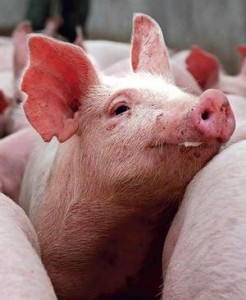 By instinct, an animal trusts us, but learns to fear us for its life By instinct, an animal trusts us, but learns to fear us for its life
.
Throat Slitting Slaughter is Immoral
The cruel practice of ‘halal slaughter‘ is one of the Islamic faith that has become a deviant abberation of that faith by men, just as the practice of patriarchal honour killings breach the ethical tenets of Islam.
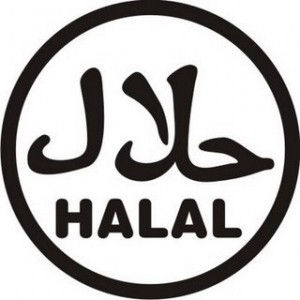 Label used for Halal Meat Label used for Halal Meat
.
A fundamental Quranic concept and a Pillar of Islam is ‘forbidding what is evil‘ and ‘opposing injustice‘. Those who choose to selectively exclude sentient beings are applying an extreme and narrow interpretation on their faith. Killing is wrong. Cruelty is wrong, evil and unjust.
Similarly, Jewish orthodox ‘kosher slaughter‘ practices prescribes ritual killing of an animal by slitting its throat with a knife. Kosher slaughter is simply a extreme and narrow interpretation of the Bible and the Torah, the Judaic scriptures. Somehow that interpretation claims that stunning before throadt slitting means the animal is unfit for Jews to eat, but nowhere in the Judaic scriptures is this explicitly prescribed.
 Label used for Kosher Meat Label used for Kosher Meat
.
Mutual respect applies not just between human beings but between humans (who have the intelligence to recognise) and all sentient beings – those living creatures that can feel, perceive or be conscious, including being able to feel pain and suffering.
Whereas morality is essential for civilised humanity, religion is a choice of faith. One’s choice of religion is a subset of human morality. Without a sound moral code, humanity descends into an uncivilised state – one that is barbaric, vicious, primitive and wicked. Those who inflict cruelty on any sentient being, either other humans or animals, act immorally. It is not as if they are ammoral (unaware of what morality is); they are decidedly immoral – they knowingly do what is wrong. Those who support the eating of animals cruelly killed are similarly immoral.
Ancient Greek society primitively and self-righteously viewed animals existing only for human benefit. The ancient Greek philosopher Aristotle viewed animals as ‘natural slaves‘ made for humans to be used as a means to an end. Aristotle assigned animals toward the bottom of a hierarchical pecking order, where somehow things lower on the chain were made for those higher on the chain. So plants were made for animals, animals were made for people, slaves were made for masters, women were made for men, and men were at the top of the earthly chain, made only for God. Aristotle was a man so may be that had somethig to to with his patriarchal world view. Civilised society rightly rejects such male hegemony and any form of enslavement.
Ancient Christianity similarly viewed animals existing only human use. In the Bible’s old testament book of Genesis, God gave man dominion over every living thing that crept on the earth. Every moving thing that lived was meant for man. Some people argue that this is the reason why animals can be treated as property, or in some cases, as machines. It is easy to justify the use of animals for food, research or pleasure when it is believed that they exist for humans.
Such narrow simplistic and self-serving world views reinforce the scope of religion being a subset of the universal holistic concept of human morality.
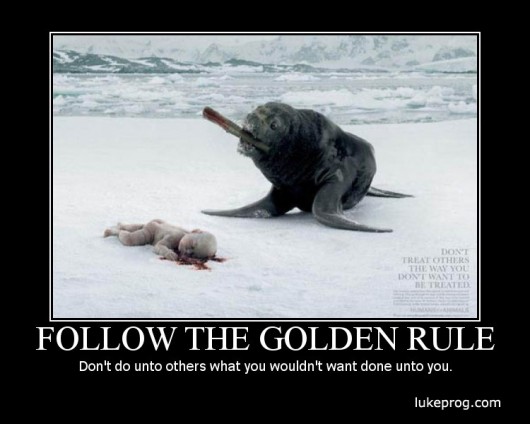
.
Animal Welfare Law in Australia
.
In modern best practice civilised societies, cruelty against animals is enshrined in law. In the United States, animals are viewed as property, but then that same society’s legislators reinstigated human torture and built Guantanamo Bay prison. Animals in the United States are segregated into being viewed as companion animals for humans, or lesser farm animals, or research animals or wildlife. It is practically an animal apartheid. In respect to the slaughter of farm animals, under the the Humane Slaughter Act in the United States ritual throat slitting is legalised.
In Germany, legislation has expressed the responsibility of human beings to protect animals. This idea steps away from the belief that animals are here for us to use as a means to an end.
In Australia, there is still no national law applying to animal welfare. Instead there is a hotch potch state and territory based regulations.
- New South Wales has its Prevention of Cruelty to Animals Act 1979
- Vic has its Prevention of Cruelty to Animals Act 1986
- Queensland has its Animal Care and Protection Act 2001
- South Australia has its Animal Welfare Act 1985
- West Australia has its Animal Welfare Act 2002
- Tasmania has its Animal Welfare Act 1993
- Northern Territory has its Animal Welfare Act
- Australian Capital Territory has its Animal Welfare Act1992
.
Even though the designated government departments charged with the administration and enforcement of the respective Acts are the primary industry departments, it is a government cop out that standard practice is to delegate enforcement to the RSPCA, a community charity.
.

The RSPCA in Australia
.
The Royal Society for the Protection of Animals is a community based charity that works to prevent cruelty to animals by actively promoting their care and protection. RSPCA Australia is a Federation of eight independent State and Territory RSPCA bodies called member Societies. RSPCA member Societies do much of the hands on work traditionally associated with the RSPCA such as the operation of shelters and the Inspectorate plus community education and fundraising.
The RSPCA’s Inspectorate’s primary role is:
- To investigate complaints of cruelty and neglect
- To provide guidance and education to animal owners where necessary
- To initiate prosecutions for offences
- To attend to sick and injured stray animals or those that have been abandoned
- To carry out regular inspections of saleyards, pet shops, abattoirs, livestock export operations, animal boarding and breeding establishments, intensive and non-traditional farms, and all places where animals are kept and used for public entertainment.
.
Editor: What a government cop out! – getting charities to do its dirty work. And how effective can a charity be to monitor, police and prosecute such industries and cultures?
.
Australian Standards for Farm Animal Slaughter
[Source: RSPCA, ^http://kb.rspca.org.au/What-is-kosher-slaughter-in-Australia_117.html]
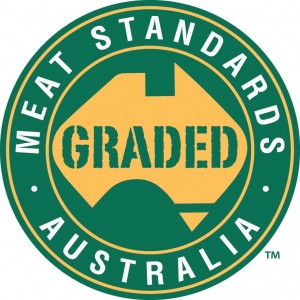
Meat Standards Australia – whose cultural definition?
.
The standard for ‘meat production‘ (aka farm animal slaughter) in Australia is that all animals must be effectively stunned (unconscious) prior to slaughter. Kosher slaughter does not comply with this standard (Ed: nor does Halal slaughter).
Despite the Australian standard requiring stunning, there are instances where the relevant Australian state or territory meat-inspection authority can provide an exemption and approve an abattoir for ritual slaughter without prior stunning – either halal or kosher – for the domestic market. For cattle and sheep, the requirements for this type of slaughter are set out in a nationally adopted guideline Ritual Slaughter for Ovine (Sheep) and Bovine (Cattle):
For cattle, this means the animal must remain in an upright position with the head and body restrained. The animal must be stunned with a captive-bolt pistol immediately after the throat is cut (known as ‘sticking’). Two separate people must perform the sticking and stunning. If there are any problems restraining the animal while attempting to stick it, then it must be stunned immediately.
For religious slaughter of sheep, the guideline requires cutting both the carotid arteries and the jugular veins. This must be confirmed — if they are not completely severed, then the animal must be immediately stunned.
Cattle and sheep requirements are different because cattle have an extra blood supply to the brain through the back of the neck. Therefore, cutting cattle’s throats results in less rapid loss of consciousness.
Kosher beef, sheepmeat and chicken are produced from animals that have not been stunned prior to having their throat cut.
‘The RSPCA is strongly opposed to all forms of slaughter that do not involve prior stunning of the animal.‘
.
The RSPCA is concerned there are greater risks of animal suffering during religious slaughter without stunning than for conventional slaughter. The number of animals involved is a tiny percentage of all animals killed but, regardless, the method is distressing to the animal due to:
- Increased restraint
- Injury caused by the slaughter methods
- Subsequent bleeding out
The use of stunning during the slaughter process can remove some, but not all, of these concerns.
The RSPCA definition of humane killing is: ‘an animal must be either killed instantly or rendered insensible to pain until death supervenes’. When killing animals for food, this means they must be stunned before slaughter so they immediately become unconscious. The RSPCA policy on ritual slaughter is clear: slaughter without prior stunning is inhumane and completely unnecessary.
The RSPCA is opposed to inhumane methods of killing and continues to promote this view to governments and the public. This view of animal welfare and animal slaughter of the RSPCA is supported by The Habitat Advocate, although we consider that concerted effort needs to be made to reduce human reliance upon animals for food.
.
End ‘cruel’ religious slaughter, say (British) scientists
[Source: ‘End ‘cruel’ religious slaughter, say scientists’, by Martin Hickman, Consumer Affairs Correspondent, The Independent (UK), 20090622, ^http://www.independent.co.uk/news/uk/home-news/end-cruel-religious-slaughter-say-scientists-1712241.html]
.
Religious slaughter techniques practised by Jews and Muslims are cruel and should be ended, says a scientific assessment from the (UK) Government’s animal welfare advisers.
The Farm Animal Welfare Council (UK) says that slitting the throats of the animals most commonly used for meat, chickens, without stunning, results in “significant pain and distress”. The committee, which includes scientific, agricultural and veterinary experts, is calling for the Government to launch a debate with Muslim and Jewish communities to end the practice.
One Muslim organisation, the Halal Food Authority, already insists on the slaughterhouses it regulates stunning animals first on welfare grounds, as long as they are still alive when their throats are slit. But in other halal and almost all kosher slaughterhouses, animals have their throats slit without prior stunning which would render them insensible to the pain. Religious groups say that doing so would be against their interpretation of religious texts.
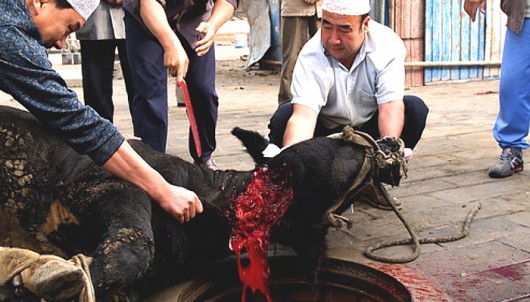
They are granted an exemption to the Welfare of Animals (Slaughter or Killing) Regulations 1995, which stipulates that creatures such as cows, goats and chickens be stunned first.
In a report into the slaughter of white meat, the Farm Animal Welfare Council (FAWC) said evidence suggested that chicken and turkeys were likely to be conscious for up to 20 seconds as blood seeped out of them. The animals are killed by a transverse incision across their neck, cutting skin, muscle, trachea, oesophagus, carotid arteries, jugular veins and major nerves.

“Such a large cut will inevitably trigger sensory input to pain centres in the brain,” the council said. “Our conclusions … are that such an injury would result in significant pain and distress … before insensibility supervenes. Fawc is in agreement with the prevailing scientific consensus that slaughter without pre-stunning causes pain and distress. On the basis that this is avoidable and in the interests of welfare, FAWC concludes that all birds should be pre-stunned before slaughter.”
While recognising the difficulties of reconciling scientific findings with matters of faith, it urged the Government to “continue to engage with religious communities” to make progress. In a 2003 report on red meat, FAWC called for ministers to repeal the religious groups’ legal opt-out.
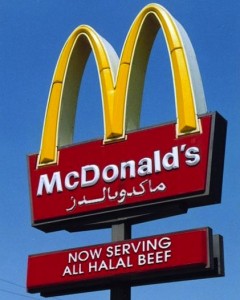
The Shechita Council, which oversees kosher meat, was contacted but did not supply a comment. Massood Khawaja, president of the Halal Food Authority, insisted that its animals were stunned, unlike those regulated by another group, the Halal Monitoring Committee. “The Koran says use your brain, ponder about things and that’s what we are doing,” he said. “It’s a question of animal welfare.”
The Government no longer keeps statistics on religious slaughter, but five years ago, the Meat Hygiene Service suggested 114 million animals were killed under halal and 2.1 million under kosher methods each year in Britain.
The Department for Environment, Food and Rural Affairs said it would not change its “long-standing policy of religious tolerance” by ending the opt-out. “And while the Government would prefer to see all animals stunned before slaughter, we will continue to ensure that required standards of animal welfare are effectively monitored and enforced in all slaughterhouses,” it said in a statement.

Last year, Lord Rooker , a minister in the department, called for meat slaughtered without stunning to be labelled for the public’s benefit, since some cuts were considered unacceptable to eat, and sold back into the food chain. The Government no longer keeps statistics on religious slaughter, but five years ago the Meat Hygiene Service suggested 114 million were killed under halal and 2.1 million under kosher methods each year.
Last night, the vegetarian organisation Viva!, Tom Lane, said: “How many times does the Government’s own advisory committe on animal welfare have to ask for a ban on slaughter without pre-stunning before action is taken? Viva! embraces multiculturalism and all religious faiths, but the suffering of these animals is so extreme that a line has to be drawn somewhere.”
 . .
What is Kosher Slaughter?
.
‘At every kosher slaughterhouse, animals are killed by a ritual cut to the neck called ‘shechita‘ that severs the esophagus and trachea (or at least one of these in the case of chickens and turkeys). Ideally, the cut also severs blood flow to the brain and, after a variable period of time, leads to unconsciousness. Jewish law specifies that a razor sharp blade must be used and that the slaughter must be performed by a properly trained individual called a shochet.
‘These rules are particularly important for animal welfare because the sharpness of the blade and its proper use seems to reduce the pain caused by the cut and speed unconsciousness. Most, though not all, authorities in halakha (Jewish law) have further argued that the animal must be conscious while shechita is performed. In non-kosher slaughterhouses, U.S. law requires that animals be stunned before being slaughtered on humane grounds.’
[Source: Jewish Vegetarians of North America, Read More: ^http://jewishveg.com/media11.html]
.
[Editor: Illegality and immorality receive a blind eye when Religion overrules State. Communities have a right to expect their political representatives to appropriately represent community values and for their government to set and maintain high standards, else community faith and trust in political process and in government are undermined].
.
The Cruelty Behind Muslim Ritual Slaughter
[Source: ‘The Cruelty Behind Muslim Ritual Slaughter‘ by Logan Scherer, PETA, 20090812, ^http://www.peta.org/b/thepetafiles/archive/2009/12/08/the-cruelty-behind-muslim-ritual-slaughter.aspx]
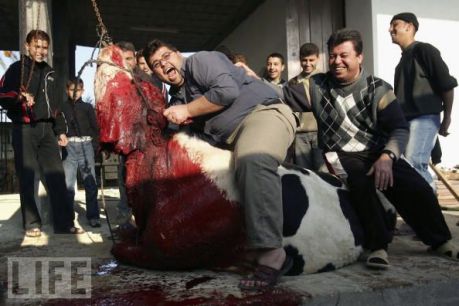
‘I’m going to be frank—after a minute and a half of Global Action in the Interest of Animals (GAIA)’s latest undercover video footage from a halal slaughterhouse in Belgium, I had to stop watching. But while I was able to hit a pause button, the more than 250,000 cows, sheep, and goats who are slaughtered while they are still conscious must endure prolonged torment. Animals killed halal (according to Islamic law) cannot be stunned before their throats are cut, which means that many animals—including the cow shown in this video—fight and gasp for their last breath, struggling to stand while the blood drains from their necks.
Belgium forbids slaughter without prior stunning, but the law does not apply to ritual slaughter practices, even though much of the halal meat produced in the country is distributed both to religious and nonreligious markets. Islamic teachings encourage kindness and compassion toward all creatures, which is why many Muslims make the humane decision to go vegan.
Visit IslamicConcern.com to learn more about cruelty-free alternatives to halal meat.
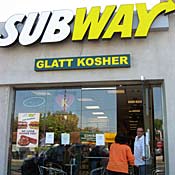
Editor: What has become regarded as politically correct has been allowed to descend into morally incorrect. Ritual slaughter is religious tolerance at any cost. If halal and kosher is permitted what is stopping tolerance of voodoo, pagan animal sacrifice, Indian Khond human sacrifice, Sumatran Batak canabalism? Humans can justify any practice on the basis of cultural tradition.
>
What has Australia’s Meat and Livestock Association have to say?
[Source: ^ http://www.mla.com.au/Livestock-production/Animal-health-welfare-and-biosecurity]

.
MLA: ‘Animal health, welfare and biosecurity are important at all stages of the livestock production chain. Each can have potentially adverse impacts on productivity if managed poorly and because producers have a duty of care to their livestock. If not upheld, these issues have the potential to reflect badly on the whole industry.’
Producers must consider the five freedoms for animals and the need to incorporate these into property management plans and procedures:
- Freedom from hunger and thirst
- Freedom from discomfort
- Freedom from pain, injury and disease
- Freedom to express normal behaviour
- Freedom from fear and distress
‘Attention to health, welfare and biosecurity is easier during good seasons, but is equally important during poor seasons or during foreseen circumstances likes floods, drought, fires and other adverse events. Special attention needs to be paid when these circumstances necessitate the humane destruction of large numbers of animals.’
.
Animal welfare
.
‘The welfare of sheep, cattle and goats affects the productivity, profitability and sustainability of the Australian livestock industries. The welfare of livestock is important during all stages of production, from birth to slaughter. Good animal welfare practices are an integral part of a property management plan.
MLA is committed to investing in animal welfare research that provides tools and knowledge to producers to help them improve the wellbeing of their livestock and address issues of community concern.’
.
Editor: Well, that is Meat Industry spin. The following articles reveal Australia’s meat industry reality.
.
Rogue abattoir not representative: government
[Source: ‘Rogue abattoir not representative: government’, 10 February 2012, AAP, ^http://www.sbs.com.au/news/article/1625242/Sydney-abattoir-shut-down-over-cruelty-concerns]
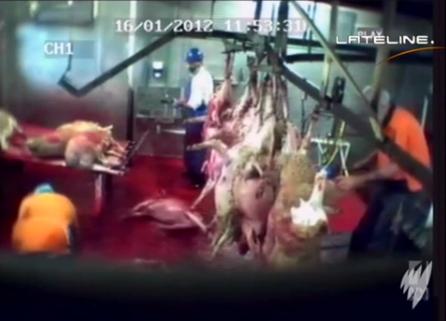 Half dead lamb writhes on the abattoir floor at the Hawkesbury Valley Abattoir
Abattoir workers (in orange) continue slaughtering other animals business-as-usual. Half dead lamb writhes on the abattoir floor at the Hawkesbury Valley Abattoir
Abattoir workers (in orange) continue slaughtering other animals business-as-usual.
.
A Sydney abattoir that has been shut down because of gross animal mistreatment is a rogue operator and not representative of the industry, the NSW Food Authority says.
The Authority suspended operations at Hawkesbury Valley Meat Processors at Wilberforce on Thursday after it received video footage depicting “acts of gross animal mistreatment”.
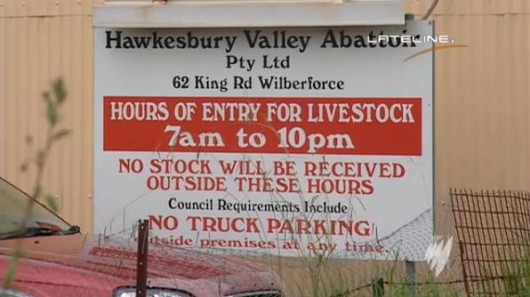
The footage, shown on ABC’s Lateline program on Thursday night, showed a worker bashing a pig several times over the head with a metal bar. [See Video – WARNING contains disturbing footage].
Another pig was hit 13 times because it had not been stunned properly.
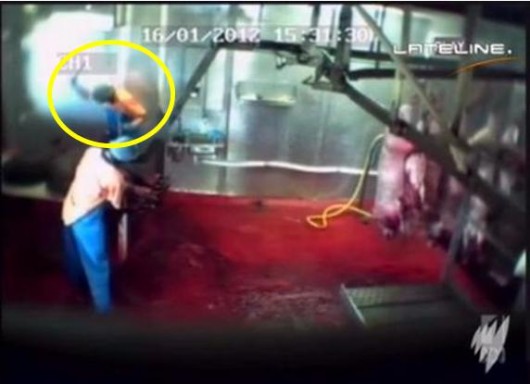 Abattoir worker bashed pigs over the head with a metal pole to kill them Abattoir worker bashed pigs over the head with a metal pole to kill them
.
Investigation Launched
.
The Authority, the RSPCA and NSW Department of Primary Industries have launched an investigation into the abattoir, while the operation has been ordered to make a submission as to why it shouldn’t lose its licence.
Peter Day, executive director of compliance at the authority, said it was the worst animal welfare breach at an abattoir that he has ever seen, but defended the industry as a whole.
“Obviously the footage we have seen, we would be of the view that it is not representative of the industry as a whole, and that this is a rogue operation, that is in no way compliant with what is expected of abattoirs,” he told reporters in Sydney.
“We will work with the relevant other agencies… to ensure that we fully uncover why this has occurred and how we can ensure operations like this don’t occur into the future.
“There is no denying that the footage is disturbing. I’m shocked. I think it is the worst case I’ve seen in an abattoir in terms of animal welfare breaches.”
.
Workers Sacked
.
Workers involved in the mistreatment of animals at a Sydney slaughterhouse have been sacked or moved to other duties, the abattoir says.
Hawkesbury Valley Meat Processors said it was extremely concerned about video footage aired on television on Thursday night showing animals being bashed to death while conscious.
“Casual staff involved in the incident have been stood down and permanent staff have been moved to other duties until the investigation has been finalised,” the abattoir said in a statement on Friday.
Hawkesbury Valley said it reported the incident to authorities as soon as it became aware of the video and was cooperating with the current investigation.
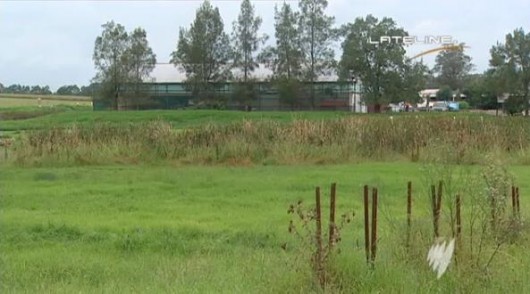 Wilberforce’s Halal House of Horror Wilberforce’s Halal House of Horror
.
Wake-Up Call
.
NSW Primary Industries Minister Katrina Hodgkinson on Friday said the footage should act as a “wake-up call” for all abattoir operators, and flagged a review of the state’s abattoirs.
“I’ve seen this footage, and it may well be a one-off, but we’re certainly going to review the operations in all abattoirs as a result of this,” she told ABC Radio.
“I want to make sure that all operations right across NSW are being conducted in a manner which follows those animal welfare guidelines.”
The body representing NSW farmers said it was appalled by the cruelty depicted in the video and welcomed the investigation into the abattoir.
NSW Farmers president Fiona Simson said animal welfare had to be a priority for everyone in the meat production chain.
“After the live export issue in 2011, our membership reaffirmed that the highest level of animal welfare should always be carried out, whether at home or abroad,” she said in a statement.
.
Call for CCTV Cameras
.
Animals Australia called for closed circuit television cameras to be installed in all Australian abattoirs.
“One of the problems is that unlike export abattoirs, domestic abattoirs don’t have an inspector or government officer on site most of the time,” campaign director Lyn White said in a statement. She said Animals Australia was calling on authorities to follow the lead of the UK where one in five abattoirs was fitted with CCTV cameras.
“Only the presence of cameras will actively discourage workers from engaging in such wanton acts of gross cruelty,” she said.
The food authority’s Mr Day said there were a number of risks with CCTV.
“It is something that we will look at in terms of whether that could have worked in this regard,” he said. “But I think that raises a lot of other questions around who watches the video, who owns the video footage, compliance and so on. I think we are really focussing on the fact that this a one off, in terms of a rogue operator. “We’ve taken the necessary action, they’re not operating now, and we’re doing our full investigation.”
.
Inspected 4 Times
.
Mr Day said the Sydney abattoir had been audited or inspected four times in 2011. “(But) there was nothing to indicate the levels of the problems that were revealed in the footage were
occurring there”.
Asked if the authority’s compliance procedures had failed, Mr Day said it carried out unannounced inspections and audits.
“I don’t know what more we can do there in that regard,” he said. “I think that our compliance program is as good as it can be at the present time.” Mr Day said part of the investigation would also look at ongoing investigation and compliance activities. “I think we need to be clear that ultimately the responsibility to comply with the legislation lies with the abattoir owner operators,” he added.
“As the regulator our action is to respond and react and take action appropriately, where we do uncover breaches, and I think we’ve done that in this regard.”
NSW Chief Veterinary Officer Ian Roth agreed that the Hawkesbury operation was a rogue operator. “We were horrified – we were shocked,” Dr Roth said.
“We think it’s very appropriate … to immediately suspend the operation at the abattoir and also to refer it to the RSPCA for a full investigation.”
Dr Roth said he had never seen cruelty like that filmed at the Sydney abattoir. “I was shocked, and we were horrified, and I obviously didn’t like it at all,” he said.
.
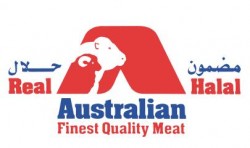 Real halal…real horror Real halal…real horror
.
Editor: How do we know this practice is not representative? From the footage it is a clear workplace culture!
.
Not a One-Off – ‘Vic abattoir probed over cruelty claims’
[Source: ‘Vic abattoir probed over cruelty claims’, by AAP, 20111125, ^http://news.smh.com.au/breaking-news-national/vic-abattoir-probed-over-cruelty-claims-20111125-1nz6r.html]
.
A Victorian pig abattoir (LE Giles Abattoir, in Trafalgar, west of Melbourne) has been ordered to stop operations while it is investigated over animal cruelty claims.
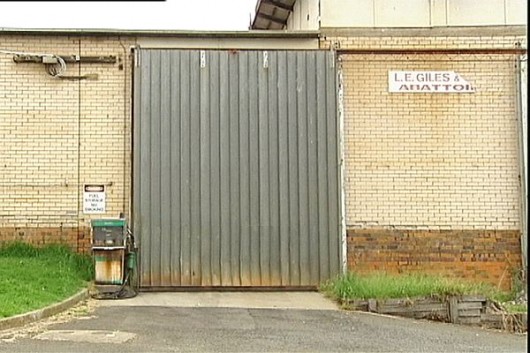 Cruel animal treatment – out of sight, out of mind Cruel animal treatment – out of sight, out of mind
.
Victoria’s department of primary industries announced on Friday it has launched a full investigation into slaughter practices at the Gippsland abattoir following serious animal welfare complaints.
Video footage allegedly taken inside the L.E. Giles and Sons Abattoir will be analysed as part of the probe, which will determine whether animal cruelty prevention laws have been broken.
PrimeSafe Victoria, which licenses the state’s domestic abattoirs, has ordered the abattoir owners to stop operations by suspending its licence.
PrimeSafe chief executive Brian Casey said he ordered the immediate cease after viewing the video footage. Mr Casey said it will vigorously pursue the complaints to ensure any inhumane treatment of animals is stamped out.
“I am appalled by the treatment of animals shown in the video footage,” he said in a statement.
As the abattoir is now prevented from slaughtering livestock, there is no ongoing risk to the welfare of livestock at the facility or to public health.
Mr Casey said he was prepared to cancel the abattoir’s licence once the probe is complete. “I have advised the abattoir owners that it is my intention, immediately the investigation is concluded, to take action with a view to cancelling their PrimeSafe licence,” he said.
PrimeSafe is empowered to cancel the operating licence of any abattoir which does not meet animal welfare standards. The investigation will also uncover any potential breaches of the Meat Industry Act.
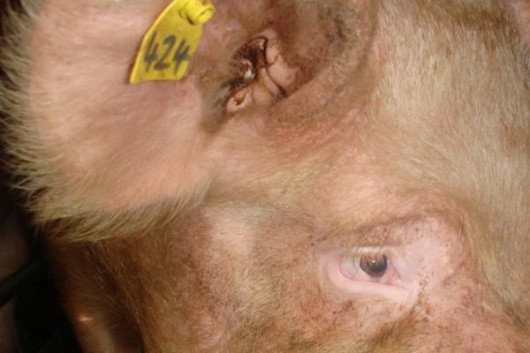 One of the abused pigs
. One of the abused pigs
.
Further Reading:
.
[1] ‘Rogue abattoir not representative: government’, 20120210, AAP, ^ http://www.sbs.com.au/news/article/1625242/Sydney-abattoir-shut-down-over-cruelty-concerns
.
[2] Royal Society for the Prevention of Cruelty to Animals (Australia), RSPCA, ^ http://www.rspca.org.au/
.
[3] http://kb.rspca.org.au/What-is-kosher-slaughter-in-Australia_117.html
.
[4] Halal Meat International Pty Ltd (Australia), ^ http://ausmeat.net/halal.html
.
[5] Animal Legal and Historical Center, USA, ^ http://www.animallaw.info/articles/ddusicacl.htm
.
[6] Luke Muehlhauser, Singularity Institute Executive Director,^ http://lukeprog.com/
.
[7] ‘ Vic abattoir probed over cruelty claims‘, by AAP, 20111125, ^ http://news.smh.com.au/breaking-news-national/vic-abattoir-probed-over-cruelty-claims-20111125-1nz6r.html
.
[8] Meat and Livestock Association ( Australia’s peak industry body joke), ^ http://www.mla.com.au/Livestock-production/Animal-health-welfare-and-biosecurity
.
[9] Islamic Concern.com, ^ http://www.islamicconcern.com/
.
[10] Jewish Vegetarians of North America, ^ http://jewishveg.com/media11.html
.
[11] ‘Activists question Australian Standards’ by Steve Cannane , ABC TV Lateline programme, 20120211, ^ http://www.abc.net.au/news/2012-02-11/activists-not-convinced-abattoir-abuse-is-isolated/3824486
.
[12] Melbourne: ‘Animal activist rescues dog from illegal abattoir’ by Maris Beck and Nino Bucci, 20120203, Hawkesbury Gazette, ^ http://www.hawkesburygazette.com.au/news/national/national/general/animal-activist-rescues-dog-from-illegal-abattoir/2442639.aspx
.
[13] Melbourne’s illegal dog meat abattoir: ‘ Peter Avraam, illegal dog meat abattoir… RSPCA did nothing!‘, by Chris Roubis, 20120206, ^ http://www.chrisroubis.com/2012/02/peter-avraam-illegal-dog-meat-abattoir-rspca-did-nothing/
.
[14] RSPCA Watchdog – a community voluntary watchdog on what the RSPCA is doing and not doing, ^ http://www.rspcawatchdog.org/articles/whatswrong.htm
.
Footnote
.
‘Trade put first when RSPCA raised issue’
[Source: ‘Trade put first when RSPCA raised issue’, by Kelly Burke, Sydney Morning Herald, 20110602, ^http://theland.farmonline.com.au/news/nationalrural/livestock/cattle/trade-put-first-when-rspca-raised-issue/2182830.aspx?storypage=0]
.
The RSPCA took its concerns over the welfare of cattle exported to Indonesia to the federal government in writing two years ago. But the animal welfare organisation was denied permission by the government to investigate, for fear of offending its closest trade partner.
The government also ignored alarm bells that rang 18 months ago, when a departmentally endorsed report designed to document the improvements Australia had achieved in Indonesian abattoirs instead identified serious animal welfare issues at the point of slaughter.
As another ship, the Hereford Express, prepared to leave for Indonesia from Darwin yesterday with about 2000 head of cattle aboard, the Australian Veterinary Association joined the growing call for an immediate ban on all live exports to Indonesia.
So far, the Agriculture Minister, Joe Ludwig, has only declared a moratorium on the supply of cattle to 11 targeted abattoirs, but has declined to specify exactly how the government might enforce such a limited ban while continuing the live export to Indonesia of some 500,000 cattle every year.
”The live export of all cattle to Indonesia should be suspended until the same animal welfare standards as Australia’s can be assured,” said the president of the Australian Veterinary Association, Barry Smyth.
“This means that pre-slaughter stunning must be mandatory and the appropriate use of restraining boxes is enforced.”
The RSPCA has told the Herald it sought to travel to Indonesia to inspect conditions in the abattoirs in 2009, but the then agriculture minister, Tony Burke, brushed off the concerns and referred the matter to the Meat & Livestock Association.
The RSPCA was subsequently refused permission to conduct its own investigation.
”There were suggestions that the minister felt it could upset the Indonesian government,” said the RSPCA’s chief scientist, Bidda Jones. ‘‘But no reason was ever given in writing.’‘
Then last November, the RSPCA received a request by the Department of Agriculture to attend a briefing in Canberra, where Dr Jones was told an independent report had found that slaughter conditions in Indonesia had been ”generally good”.
Dr Jones received a copy of the report, which had been completed six months earlier. The Herald has also since obtained a copy of the report, which documents a variety of substandard practices that would be illegal under Australian laws and in violation of international guidelines.
Examples included head slapping, where the panicked prostrate animal constantly bangs its head on the steel draining trough as a result of the design of the Australian Mark 1 boxes, and the finding that the average number of cuts to an animal’s throat prior to loss of conscience was four, with up to 18 cuts recorded.
”From the information available in the report it is clear that the majority of the animals observed were subjected to significant levels of pain, fear and distress during handling and an inhumane slaughter,” Dr Jones’s analysis concluded. ”It is therefore both perplexing and extremely disappointing that the report takes the range of conditions observed and summarises them into one sentence: ‘Animal welfare was generally good’.”
.
What’s wrong with the RSPCA?
Despite the hard work of volunteers, RSPCA management consistently fails animals.
by Patty Mark and Erik Gorton
.
Q. Why is the RSPCA in business with the largest battery egg producer in Australia?
The RSPCA says it’s against the cruel battery cage yet maintains a business arrangement and accepts sponsorship from Pace Farms, Australia’s largest battery egg producer. The RSPCA say their Liberty Barnlaid Egg Endorsement Scheme with Pace will ensure some hens get out of their cages, yet the number of battery hens in cages has not decreased while the RSPCA gets paid (to date) over $182,560 in royalty payments. Meanwhile, Pace Farms has just built the largest battery hen factory in the southern hemisphere (West Wyalong).
.
Q. Why does the RSPCA justify overcrowding, beak mutilations, lack of perches, prevention of roosting, chronic stress and electric shock training to the hens they abuse for their barnlaid approved eggs?
The Animal Liberation Victoria undercover rescue team repeatedly videotape and photograph all of the above cruelties inside RSPCA approved barnlaid sheds.
.
Q. True or False: The RSPCA is the only animal organisation legally able to prosecute for cruelty in Victoria?
True. (Section 24 of the Prevention of Cruelty to Animals Act – POCTA). Other Victorian animal organisations depend on the RSPCA to investigate their cruelty complaints. For twenty years Animal Liberation Victoria has presented clear violations and gross suffering in egg-laying factories, broiler chicken sheds and intensive piggeries, yet the RSPCA ignores this evidence and fails to prosecute.
.
Q. How often do the RSPCA routinely inspect those businesses and industries that use the majority of animals in Victoria?
Chickens are the most numerous animals used in Victoria requiring the protection of the RSPCA.
Millions of birds in hundreds of breeding farms, battery/barnlaid and free-range egg farms, and broiler (chicken meat) farms rated only three routine inspections in 2002. The inspections are cursory. What hope do the animals have, especially if inspections are at Pace Farms?
.
Q. Killing them softly? Is the RSPCA involved in sending animals to the slaughterhouse?
The RSPCA is also in business with pig producers. Otway Pork was a sponsor of 2006’s Million Paws Walk and the RSPCA makes $$$ from pigmeat sold by Otway Pork. Pigs are as intelligent as dogs. Would the RSPCA send all the unclaimed lost dogs who they euthanise to a slaughterhouse to be electrically prodded, terrorised, have their throats slit, then hung up by one leg to bleed out, with some possibly entering a scalding tank alive? Ask them why they treat pigs this way.
.
Q. What creatures (great and small) does the RSPCA serve or cook at it’s fund-raisers and family days?
The RSPCA consistently serves animal flesh at their public functions knowing the enormous pain and terror these animals suffered during their rearing, transport and finally their slaughter at the abattoir. There are numerous meat-free alternatives they could use to spare these creatures this torment while also leading the community forward with a truly humane and healthy food choice.
.
Q. What did the RSPCA do to help 378 dogs at a cruel Ballarat Puppy Farm?
Eurovision’s Puppy factory which was situated near Ballarat had been farming thousands of puppies in extremely cruel conditions for over twenty years. Repeated evidence of abuse presented to the RSPCA was dismissed, who claimed that the farm’s operations were legal. After video evidence of an undercover rescue was presented, the RSPCA still maintained “No animal welfare issues observed”. Finally, sustained protests and lobbying of Ballarat’s local council by campaigner Debra Tranter and Animal Liberation Victoria resulted in the farm’s closure due to appalling conditions.
The RSPCA then delivered it’s greatest slap in the face when it mislead the public in it’s newsletter, implying that the closure of the factory was due to their efforts! A very cleverly worded article proclaimed the closure of the Puppy factory, and while it never actually claimed victory, the clear impression given to the reader was that the RSPCA had ordered the closure.
.
Q. How is the RSPCA currently handling the case of starving horses in Tolmie?
For seven months now the RSPCA have issued four compliance notices to an animal hoarder who has red-worm infested horses in her care. To date, nine horses have died as a result of insufficient nutrition and lack of adherence to a proper rehabilitation regime. Many more horses are still in danger and yet the RSPCA refuses to seize the horses, claiming that they cannot do so while the owner complies with veterinary advice. The RSPCA appointed vet, however, has since discontinued involvement due to frustration that the owner is not following the procedures he has set out. (Read: ‘RSPCA fails horses in need‘ for the full story).
.
Editor:
Australian Governments (national and state) are turning a blind eye to animal cruelty in farming and this is unacceptable. Agriculture Minister, Joe Ludwig, needs to be sacked for gross neglect and immoral complicity. The MLA’s previous bossDon Heatley and the Cattle Council’s past boss Greg Brown need to be investigated and both organisations wound up over complicity in the known cruelty of the Indonesian livestock trade.
.
Reform Initiative:
The current inspectorate functions of the RSPCA charity is a government cop out of responsibility for law and order. That animal welfare is regulated undre multiple state-based systems is a legacy of colonialism. The entire inspectorate role needs to be wholly transferred to a new dedicated national agency, fully national government-funded and transparently independent from industry and government departments. Essentially this is a veterinary standard that applies to all animals in Australia – farmed, companion animals, and wildlife. So perhaps a suitable title for the new agency should have a veterinarian board of management and be called the Australian Animals Police to operate under a strict new national Animal Crimes Act.
Refer to previous The Habitat Advocate articles on this issue:
.
.
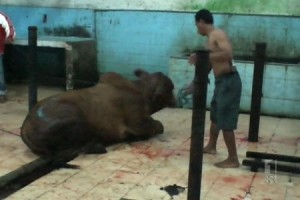 Photo extract of infamous secret video of Indonesian abattoir barbarism
…don’t travel to Indonesia. Boycott this backward country! Photo extract of infamous secret video of Indonesian abattoir barbarism
…don’t travel to Indonesia. Boycott this backward country!
.
Tags: Animal Crimes Act, animal cruelty, Animal Welfare Law, Australian abattoirs, Australian Animals Police, Farm Animal Welfare Council, Halal KFC, Halal McDonalds, halal slaughter, Halal Subway, Hawkesbury Valley Abattoir, Kosher McDonalds, kosher slaughter, Kosher Subway, L.E. Giles and Sons Abattoir, Meat and Livestock Association, Meat Standards Australia, religious slaughter, RSPCA, The Golden Rule, Throat Slitting Slaughter, throats slit
Posted in Threats from Farming | 4 Comments »
Add this post to Del.icio.us - Digg
Leave a Reply
You must be logged in to post a comment.
February 7th, 2012
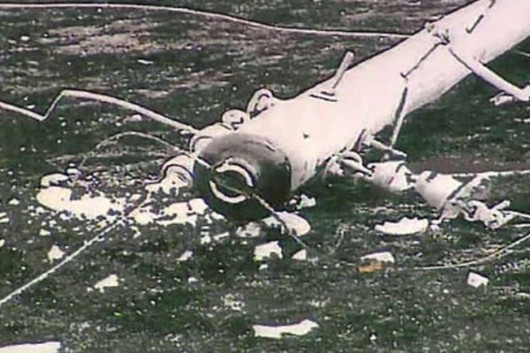 SP AusNet’s power pole near the one believed to have ignited the East Kilmore Bushfire of 2009
(Source: ABC, ^http://www.abc.net.au/news/2009-11-18/this-power-pole-is-near-where-the-kilmore-bushfire/1159986) SP AusNet’s power pole near the one believed to have ignited the East Kilmore Bushfire of 2009
(Source: ABC, ^http://www.abc.net.au/news/2009-11-18/this-power-pole-is-near-where-the-kilmore-bushfire/1159986)
.
Today marks the third anniversary of the 2009 Victorian Bushfires. People reading this do so because they are interested in understanding and seeking answers, and so do I. This is one reason why I write. (Editor)
After a Royal Commission and much government promising, the test of faith is do people in regional Victoria feel safer from the risk of bushfire and confident that the subsequent actions by government at all levels are better prepared to mitigate a repeat of 2009?
The first two terms of reference of the Royal Commission into the 2009 Victorian Bushfires were to investigate:
1. ‘The causes and circumstances of the bushfires which burned in various parts of Victoria in late January and in February 2009 (“2009 Bushfires”).’
2. ‘The preparation and planning by governments, emergency services, other entities, the community and households for bushfires in Victoria, including current laws, policies, practices, resources and strategies for the prevention, identification, evaluation, management and communication of bushfire threats and risks.’
.
The underlying premise of the entire investigation was not about attributing individual blame per se, although some of that has been attributed two a few individuals, but to understand why the devastation was of such a scale and impact, with a view to learn from the tragedy and to better prepare for the future. Loved ones cannot be returned, but from their loss our society needs to learn and protect itself from a repeat. It has happened before. This editor was in Melbourne during the 1983 Ash Wednesday bushfires. It must not happen again.
.
Causes of the 2009 Victorian Bushfires
.
People rightly wanted to know the direct causes and circumstances of the fires, about emergency management of the fires, bushfire detection, the warnings given or not given, about bushfire preparedness.
Well the final report of the Royal Commission grouped the causes of the bushfires according to their separate geography as follows:
1. Delburn Fires cause: “suspicious“
2. Bunyip Fire cause: “suspected lightning“
3. Kilmore East Fire cause: “electrical failure“
4. Horsham Fire cause: “electrical failure“
5. Coleraine Fire cause: “electrical failure“
6. Pomborneit–Weerite: “electrical failure“
7. Churchill Fire cause: “suspicious“
8. Murrindindi Fire cause: “suspicious“
9. Redesdale Fire cause: “undetermined“
10. Narre Warren at Harkaway cause: “accidental“; at Lynbrook: “not determined“
11. Upper Ferntree Gully Fires cause: “unknown“
12. Bendigo Fire cause: “suspicious“
13. Beechworth–Mudgegonga Fire: “electrical failure“
.
“Most of the major fires that burned in late January and in February 2009 started as a direct or indirect result of human activity.”
.
Main Cause: Overhead Electricity Arcing of a neglected SP AusNet Asset
.
Failure of electricity assets owned and neglected by SP AusNet was responsible for five fires—Kilmore East, Beechworth–Mudgegonga, Horsham, Coleraine and Pomborneit–Weerite.
The causes of four fires—Murrindindi, Churchill, Delburn and Bendigo—are thought to be suspicious (i.e. arson). One fire—Harkaway—was started accidentally. Only the Bunyip fire is thought to have been the result of natural causes (lightning), although fire investigators have been unable to definitively reach this conclusion. The causes of both Lynbrook fires and the Upper Ferntree Gully and Redesdale fires are not known.”
[Source: 2009 Victorian Bushfires Royal Commission, Final Report, July 2010, Volume 1, Chapter 15.1 Conclusions – Fire causes, p.226]
.
These conclusions are far from satisfactory, given the considerable resources and expertise made available to the Royal Commission, and that its number one task from to identify the exact causes of the fires. Why are the conclusions so vague? Is it symptomatic of the inadequacies of CFA bushfire monitoring and investigation skills? What were the delays between the estimate ignitions and the respective onground investigations?
It is easy to become bamboozled by the complexity of the many separate bushfires and their respective causes, the contributing factors and varying responses, and particularly since the Royal Commission final report is so long and unwieldy. I don’t think anyone questions that the bushfire conditions were characterised by many years of drought producing tinder dry bushland and extreme heat and low humidity on the day, which all produced an ‘unprecedented‘ extreme bushfire risk.
But of all the bushfires that occurred in the lead up to and on the day of 7th Februray 2009, the single bushfire that caused the most destruction and tragic loss of life was the Kilmore East Fire. The Kilmore East Fire started about 85 kilometres north of Melbourne and ended up burning easterly across the Hume Highway through the shires of Whittlesea, Nillumbik, Mitchell and Yarra Ranges extending south east 70km.
It burnt through the towns of Wallaby Creek, Humevale, Strathewen, Kinglake, Kinglake West, Clonbinane, Steels Creek, Chum Creek, St Andrews, Dixons Creek, Yarra Glen, and Strathewen. Then the wind changed southerly and raged the fire on to Pheasant Creek, Yabamac, Flowerdale, Hazeldene, Castella, Break O’Day, Glenburn and Toolangi.
The fire burnt an overall area of 125,383 hectares, roughly 70 km long and 20 wide, as shown on the following fire map.
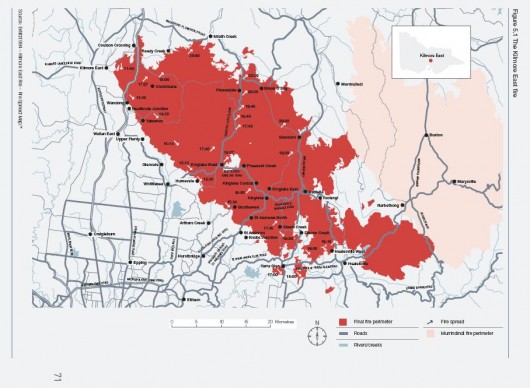 Kilmore East Fire (dark red area)
Click to see enlarged map (320kb) – arrows show when and where the fire wind changed Kilmore East Fire (dark red area)
Click to see enlarged map (320kb) – arrows show when and where the fire wind changed
The adjacent fire (pink area) was the Murrindindi Fire which was started by arson (deemed “suspicious” by the Royal Commission)
(Source: VBRC Final Report Vol. 1, Chapter 5, p.71)
.
Of the 173 reported human deaths of the 2009 Victorian Bushfires, 119 (most) were as a consequence of the Kilmore East Fire, which had initially been ignited by a powerpole electrical failure. Another 232 casualties were reported and some 1,242 houses were destroyed by the Kilmore East Fire.
Ultimately, the Victorian Government here is accountable for its delegated arrangements to provide essential services such as electricity supply to the people of Victoria. That Victorian Government under Premier John Brumby and its various prior policies under different political persuasions, chose to outsource electricity provision to a private operator, no less diminishes the Victorian Government’s fuduciary duty for that supply and all its component standards including reliability and least of all, safety. Morally and legally in Australia, no government can outsource its fiduciary duty and then wipe its hands of that fiduciary duty. Both then Victorian Premier Brumby and then Prime Minister Rudd must fall on their swords.
The Kilmore East Fire ignited at midday on 7th February 2009 from electrical arcing at the top of a rocky hill between two gullies near Saunders Road in Kilmore East. A Single Wire Earth Return (SWER) electricity line (the conductor) ran across the gullies. The area where the fire started was undulating pasture interspersed with native vegetation alongside cleared and standing forestry plantations. The conductor formed part of the Pentadeen Spur power line.
The fire started after the conductor between two power poles failed and the live conductor came into contact with a cable stay. This contact caused arcing that ignited vegetation near the base of one of the poles. An electrical fault was recorded at 11:45am. The conductor failed as a result of fatigue on the conductor strands very close to where a helical termination was fitted to the conductor at the pole. The conductor was about 43 years old. A line inspection carried out in February 2008 had failed to identify the incorrectly seated helical fitting.
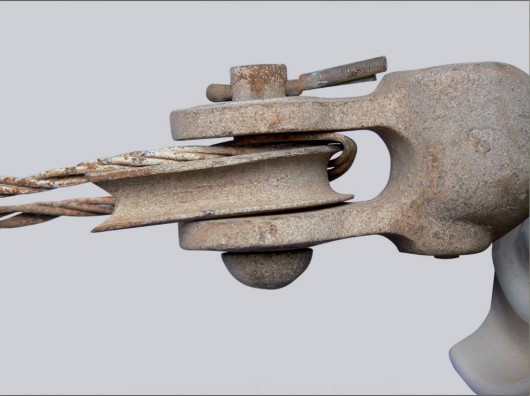 An ill-designed and jammed helical termination
(Click to enlarge and bloody frame if you want!) An ill-designed and jammed helical termination
(Click to enlarge and bloody frame if you want!)
(Source: VBRC, Exhibit 525 – HRL Technology Report – Kilmore East Fire)
.
Within two minutes, a fire tower observer at Pretty Sally tower, Peter Coleman, spotted a column of white smoke at 11:47am about 30 to 40 metres high coming from behind a hill in the direction of Saunders Road, Kilmore East. The fire was reported to the CFA two minutes later at 11:49am.
The volunteer Victorian Country Fire Authority (CFA) Clonbinane Brigade fire truck initially responded, but requested additional resources as it was of an uncontrollable size and was spotting ahead of the fire front into bushland. A decision to escalate the bushfire emergency to an Incident Management Team (IMT) was put in place at 4:30pm, some four and a half hours later in unprecedented extreme bushfire risk conditions and just as the now firestorm was impinging upon the communities of Humevale and Kinglake West – over 20km from the ignition.
[Source: 2009 Victorian Bushfires Royal Commission, Final Report, July 2010, Volume 1, Chapter 5.6 The Kilmore East Fire – Conclusions, pp.75-84]
.
In relation to those bushfires collectively attributed by the Royal Commission as being caused by ‘electrical failures‘, the Commission’s recommendations were:
- Replace ageing powerlines with safer bundled or underground cables
- High-risk areas should have all lines replaced within 10 years and inspected within 3 years
.
Specifically the Royal Commission’s recommendations were:
.
Recommendation # 27:
Progressive replacement of all single-wire earth return power lines in Victoria with aerial bundled cable, underground cabling or other technology that delivers greatly reduced bushfire risk. The replacement program should be completed in the areas of highest bushfire risk within 10 years and should continue in areas of lower bushfire risk as the lines reach the end of their engineering lives the progressive replacement of all 22-kilovolt distribution feeders with aerial bundled cable, underground cabling or other technology that delivers greatly reduced bushfire risk as the feeders reach the end of their engineering lives. Priority should be given to distribution feeders in the areas of highest bushfire risk.
.
Recommendation #28:
Electricity distribution businesses to inspect all SWER lines and all 22-kilovolt feeders in areas of high bushfire risk at least every three years.
.
Recommendation #29:
Electricity distribution businesses to review and modify their current practices, standards and procedures for the training and auditing of asset inspectors to ensure that registered training organisations provide adequate theoretical and practical training for asset inspectors.
.
Recommendation #30:
Electricity distribution businesses adopt measures to reduce the risks posed by ‘hazard trees’
.
Recommendation #31:
Municipal councils include in their municipal fire prevention plans for areas of high bushfire risk provision for the identification of hazard trees and for notifying the responsible entities with a view to having the situation redressed.
.
Recommendation #32:
Electricity distribution businesses to disable the reclose function on the automatic circuit reclosers on all SWER lines for the six weeks of greatest risk in every fire season, adjust the reclose function on the automatic circuit reclosers on all 22-kilovolt feeders on all total fire ban days to permit only one reclose attempt before lockout.
.
Recommendation #33:
Electricity distribution businesses to fit spreaders to any lines with a history of clashing or the potential to do so fit or retrofit all spans that are more than 300 metres long with vibration dampers as soon as is reasonably practicable.
.
Recommendation #34:
The State amend the regulatory framework for electricity safety to strengthen Energy Safe Victoria’s mandate in relation to the prevention and mitigation of electricity-caused bushfires and to require it to fulfill that mandate.
[Source: 2009 Victorian Bushfires Royal Commission, Final Report, July 2010, Volume 1, Summary & Recommendations, pp.29-30]
.
The test of faith is do people in regional Victoria feel safer from the risk of bushfire and confident that the subsequent actions by government at all levels are better prepared to mitigate a repeat of 2009?
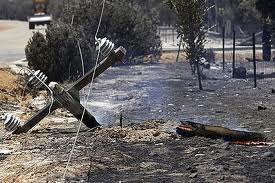 . .
Tags: 2009 Victorian Bushfires, Break O'Day, bushfire arson, Castella, causes, Chum Creek, Clonbinane, Dixons Creek, Failure of electricity assets, Flowerdale, Glenburn, Hazeldene, Humevale, jammed helical termination, Kilmore East, Kilmore East Fire, Kinglake, Kinglake West, Murrindindi Fire, Pheasant Creek, Power pole, recommendation, Regional Victoria, Singapore Power, SP AusNet, St Andrews, Steels Creek, Strathewen, Toolangi, Victorian Bushfires Royal Commission, Wallaby Creek, Wong Kim Yin, Yabamac, Yarra Glen
Posted in Threats from Bushfire | No Comments »
Add this post to Del.icio.us - Digg
Leave a Reply
You must be logged in to post a comment.
February 2nd, 2012
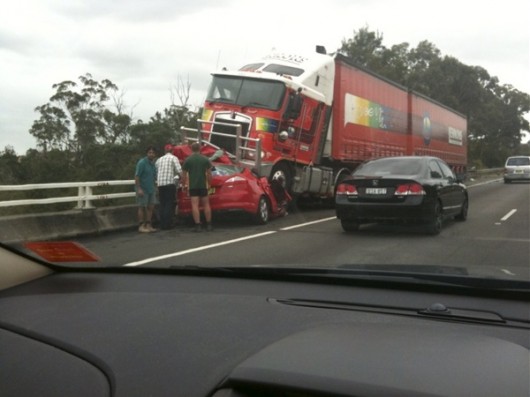 No chance!
A B-Double crosses the wrong side of the Hume Highway
and slams head-on into a car killing all three occupants No chance!
A B-Double crosses the wrong side of the Hume Highway
and slams head-on into a car killing all three occupants
.
Last Friday, a brick-laden truck crossed a grass embankment, crashed through a guard rail and ended up on the opposite side of the Menangle Bridge on the Hume Highway south of Sydney. It slammed head-on into a car killing the three people inside.
[Source: ‘From joy to instant death‘, by Nick Ralston, 20120125, Illawarra Mercury, ^http://www.illawarramercury.com.au/news/local/news/general/from-joy-to-instant-death/2432730.aspx]
.
It is only a matter of time before such a tragedy befalls the Great Western Highway in the Blue Mountains as more and more B-Doubles ply this regional route.
Driving along many highways throughout Australia has become deadly as more and bigger trucks travel faster just a metre away on the other side of a white line or two. Not only are there more semi-trailers, but trucking companies are increasingly putting larger capacity B-double trucks on the road, which can weigh over 70 tonnes.
When 70 tonnes hits you it is an instant wall of death.
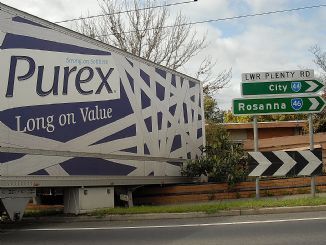 A speeding semi ploughs into the front yard of a home in Rosanna,
in eastern Melbourne on 21st September 2010 A speeding semi ploughs into the front yard of a home in Rosanna,
in eastern Melbourne on 21st September 2010
.
Yet both Liberal and Labor governments at both national and state level are pouring billions of taxpayer dollars to facilitate more road freight on Australian highways, while ignoring the comparative line haul efficiencies and inherent safety of rail freight.
In 1998, the New South Wales Labor Government announced a 12-year $360 million ‘upgrade’ of the Great Western and Mitchell Highways between Penrith (outer Sydney) and Orange in the central west of NSW. In addition, the Federal Liberal-National Coalition Government committed an extra $100 million as part of its Auslink National Network.
The ‘upgrade’ meant transforming the two lane regional highway over the Blue Mountains into a four lane 80kph expressway to facilitate greater and faster trucking – a ‘trucking expressway‘. The then promoted features of this new trucking expressway were to be:
- Widening of the highway to a four lane, divided road between Penrith and Katoomba
- Widening the highway to mostly three lanes between Katoomba and Mount Victoria (including Blackheath)
- Providing additional overtaking lanes along stretches of the highway
- Improving pedestrian and traffic facilities at intersections crossing the highway in townships
- providing bicycle facilities along the highway
- Extensive landscaping and urban design initiatives within Blue Mountains towns and villages.’
.
[Source: NSW Roads and Traffic Authority Great Western Highway Upgrade’ brochure, January 2002]
.
Well, the widening is certainly carving through Blue Mountains communities and bushland. Pedestrian walkways and crossings are few and far between and the few cycle lanes are within a metre of B-doubles hurtling along at 80kph – those that stick to the speed limit. Who’d be a cyclist on the Great Western Highway now unless one had a death wish?
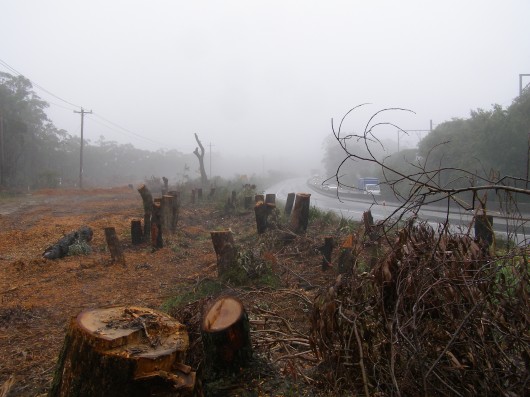 Destruction in progress yesterday at Boddington Hill, east of Wentworth Falls
Great Western Highway Blue Mountains
(Photo by Editor 20120201, free in public domain, click photo to enlarge) Destruction in progress yesterday at Boddington Hill, east of Wentworth Falls
Great Western Highway Blue Mountains
(Photo by Editor 20120201, free in public domain, click photo to enlarge)
.
In September 2008, the then Federal Labor MP Bob Debus for the Macquarie electorate (covering the Blue Mountains region) committed another $450 million on the Great Western Highway to bypass the village of Mount Victoria and River Lett Hill near Lithgow.
Debus revealed the purpose of the widening on his website:
.
“The bypass will halve times between Mt Victoria and Lithgow, reduce accidents by two-thirds, and improve freight transport from the Central West .
The bypass will provide a route on the western escarpment more suited to the operation of heavy vehicles than the current Victoria Pass…”
.
[Source: ‘Bob Debus for Macquarie E-news #2‘, Bob Debus MP website, ^http://www.bobdebus.com/newsletter2.html (page since defunct since Debus has resigned from Federal Parliament]
.
The joint Labor-Liberal policy focus on developing road freight and ignoring rail freight is short-sighted 20th Century truck thinking. But it is also meaning our regional highways are morphing into bigger and faster freight routes – trucking expressways. Local communities are having to share regional roads with huge trucks.
The trucking industry has allowed itself to become largely contract based where drivers instead of being paid for their time driving are paid on a trip rate. This means that the more trips a driver makes and the faster the delivery times, the more money the drivers earn. This work arrangement only encourages truck drivers to drive faster, often too fast, with disastrous consequences.
.
‘It is a statistic that will alarm police and governments dealing with a string of fatal road accidents: almost two thirds of long haul truck drivers interviewed for a national study say their employers pressure them into using unsafe work practices.’
[Source: ‘Truckies pushed into danger zone’, by Andrew West, Sydney Morning Herald, 20100109, p.2]
.
Recent fatalities on NSW roads , including the death of an 11-year-old boy, have sparked a renewed call for action on trucks in the Mountains.
Deputy Mayor Mark Greenhill moved a matter of urgency at Blue Mountains City Council (BMCC) meeting 31st January 2012, calling on state and federal government representatives to meet with BMCC to discuss “means and methods by which large trucks can be limited or controlled in terms of behaviour on the Great Western Highway over the Blue Mountains” following several shocking incidents in other areas of the state.
Clr Greenhill: “While the courts have not yet had a chance to determine guilt or otherwise, and I don’t seek to either, recent accidents on NSW roads stand testimony to the awesome power of these trucks,” he said. “In the Campbelltown area a large truck went over the top of a car and killed three people. They had no chance. In coastal NSW a boy was killed while sleeping in his house when a large truck ploughed through it.”
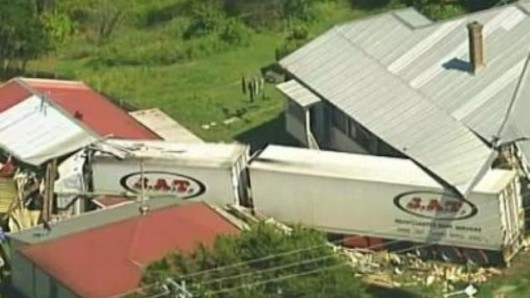 Eleven-year-old boy killed when a B-double crashes through his bedroom
Anyone living within 100 metres of a highway has got cause for concern Eleven-year-old boy killed when a B-double crashes through his bedroom
Anyone living within 100 metres of a highway has got cause for concern
.
Penrith residents are mourning the death of Max MacGregor, the 11-year-old killed when a truck loaded with bananas crashed through his bedroom on the state’s mid-north coast. Max was asleep in the holiday home his family were renting in Urunga when, at 5am on Sunday, a B-double semi collided head-on with a ute before swerving into the holiday home (100 metres from the highway).
[Source: ‘B-double fatality on mid-north coast brings Penrith family’s holiday to tragic end’, by Emma Schiller, 20120110, Penrith Press, ^http://penrith-press.whereilive.com.au/news/story/penrith-familys-holiday-tragedy/]
.
Clr Greenhill: “When things go wrong and [trucks] are out of control, they are an uncompromising and deadly weapon. “In that context, people have been killed in significant numbers in the Blue Mountains. It is a scandal to me that governments are not doing more to control tucks on the highway across the Mountains. “This should especially be the case while the highway works are under way.”
Clr Greenhill released BMCC figures in September last year that showed trucks were over-represented in local crash statistics and motorists were three times more likely to die in a collision with one. The statistics showed that from 2005 to 2009, trucks represented nearly a third of all vehicles involving deaths despite being less than a third of vehicles on local roads. Three per cent of all truck crashes were fatal, compared to one per cent of crashes by all other vehicles, the figures showed.
Clr Greenhill said he had reports from local residents about large trucks “even braving the Old Bathurst Road bends”, and said he would like to see vehicles such as B-doubles off local roads for the time being.’
[Source: ‘Tragedies spark call for action on trucks’, by Krystyna Pollard, 20120201, Blue Mountains Gazette, ^http://www.bluemountainsgazette.com.au/news/local/news/general/tragedies-spark-call-for-action-on-trucks/2440033.aspx]
.
‘Give Rail a Go’
[Source: Letter to the Editor, Blue Mountains Gazette, 20120201, p4]
.
The tragic accident involving a 25/26m B-double truck at Menangle last week reaffirms the fact that the Great Western Highway, even after the upgrade to Katoomba is completed, will never be suitable for these massive trucks.
Yet the federal government is funding stage one of a multi-billion dollar highway bypass between Mt Victoria and Lithgow, the main purpose being to allow 25/26/30m B-double trucks carrying up to 77 tonnes to use the highway through the Blue Mountains. Despite overwhelming community disapproval the federal government is pushing ahead with stage one, a purpose built 25/26/30m B-double bypass at River Lett Hill.
The Blackheath Highway Action Group along with many other Blue Mountains Groups successfully lobbied for an independent review to be conducted on the proposed Mount Victoria to Lithgow highway bypass and the future of the highway west of Katoomba. In July 2011 the NSW government appointed Evans and Peck, a firm with local knowledge to conduct this review. the review was completed in November so why is the federal government stalling on its public release?
The federal government refuses to fund a $5 million rail study, a key recommendation of the Central West Transport Needs Study. Rail deserves the same funding, tax incentives and regulatory framework as is currently given to support long haul trucking.
For the sake of safety, local amenity and the long term sustainability it’s time to give rail a fair go and permanently abandon plans to spend billions to turn our highway inot a 25/26/30m B-double freight corridor.’
~ Michael Paag, Chairman, Blackheath Highway Action Group, Blue Mountains
.
‘Head-on crash: driver dies as truck explodes’
[Source: ‘Head-on crash: driver dies as truck explodes’, by Glenda Kwek, 20120124, Sydney Morning Herald, ^http://www.smh.com.au/nsw/headon-crash-driver-dies-as-truck-explodes-20120124-1qehm.html]
‘A driver has died after a truck caught fire and exploded following a head-on collision between the tabletop truck and B-double took place about 24 kilometres south of Dubbo at Mountain Creek Road about 4am, emergency services said. The Newell Highway in Dubbo is closed in both directions between Mitchell Highway and Tomingley Road. The tabletop truck was carrying food and plastic food containers, and the B-double was carrying fertiliser, Ms O’Connor said.’
.
‘Orange truck rollover’
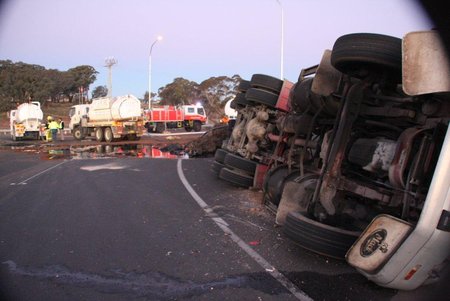 Truck Roll Over at the intersection of Burrendong Way & The Northern Distributor
Orange, Central NSW, 20100629
[Source: ‘Orange truck rollover’ by Steve Smith, Rural Fire Service, Canobolas, ^http://www.canobolas.rfs.nsw.gov.au/dsp_content.cfm?cat_id=131107] Truck Roll Over at the intersection of Burrendong Way & The Northern Distributor
Orange, Central NSW, 20100629
[Source: ‘Orange truck rollover’ by Steve Smith, Rural Fire Service, Canobolas, ^http://www.canobolas.rfs.nsw.gov.au/dsp_content.cfm?cat_id=131107]
.
‘Teenage driver killed in truck collision’
[Source: ‘Teenage driver killed in truck collision’ by Ellen Lutton, 20111218, Brisbane Times with AAP, ^ http://www.brisbanetimes.com.au/queensland/teenage-driver-killed-in-truck-collision-20111217-1p0ax.html]
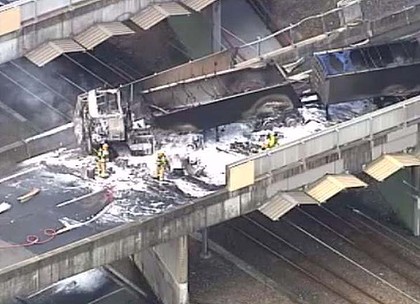
‘One woman was killed and five people were injured in two accidents involving B-double trucks. Engineers were called to the scene of a dramatic accident on the Gateway Motorway at Boondall in Brisbane about midday yesterday, when a B-double truck exploded after it and a car collided. The intensity of the explosion and subsequent fire was so severe that parts of the truck fused together, raising concerns about damage to the road and overpass bridge underneath, a police spokeswoman said.
(Meanwhile) on the Bruce Highway near Rockhampton, a 19-year-old woman died and four people were injured when a car and a B-double truck collided. Police said the station wagon tried to turn into the southbound lanes of the Bruce Highway at Marmor just before 8pm on Friday when the car and truck, which was travelling in the northbound lane, collided.
The 19-year-old driver was killed, while her three female passengers, two aged 19 and one aged 18, were taken to Rockhampton hospital. The three are in a stable condition.The 65-year-old driver of the B-double was taken to hospital for precautionary treatment and has been released.
.
‘Three trucks involved in two separate highway collisions’
[Source: ‘Three trucks involved in two separate highway collisions’, by Wendy Marshall and Kate Moody, 20100408, Daily Liberal, ^http://www.dailyliberal.com.au/news/local/news/general/three-trucks-involved-in-two-separate-highway-collisions/1797078.aspx]
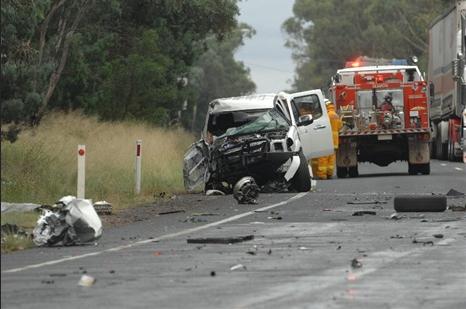
A 50-year old man was taken to Dubbo Base Hospital with serious injuries after a collision between a B-double truck and a utility vehicle, occurred about 1.15pm on the Newell Highway just south of Gilgandra.
Earlier in the day, in a separate accident, two trucks collided 25 km outside of Dubbo on the Golden Highway. A UD truck crashed into the back of a Mitsubishi Canter turning right at the Barbigal Road turn off to Wongarbon about 11.40am yesterday.
At the scene, Ballimore RFS deputy captain Col Buckler said the Golden Highway was not currently built for trucks and “most definitively” needed upgrading.
“This is the official B-double road to Newcastle (and) the roads need to be built to carry trucks,” Mr Buckler said. “It’s time they spent money to make it safer because of the amount of trucks that use it.”
.
‘Fatal crash between car and truck causes explosion, closes Pacific Highway’
[Source: ‘Fatal crash between car and truck causes explosion, closes Pacific Highway’, by Nathan Klein, The Daily Telegraph, 20110405, ^http://www.news.com.au/fatal-crash-between-car-and-truck-closes-pacific-highway/story-e6freuy9-1226033739809?from=public_rss]
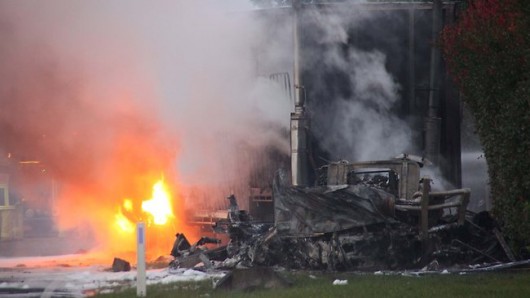 Flames … scenes from a fatal crash between a B double truck and a car on the Pacific Highway south of Macksville.
(Photo by Frank Redward) Flames … scenes from a fatal crash between a B double truck and a car on the Pacific Highway south of Macksville.
(Photo by Frank Redward)
.
AT least one person has been killed in the fiery collision between a car and a B-double truck at Warrell Creek, about 10km south of Macksville, just before 4am today.
“The B-doubles can’t pass using the diversion as the rail overpass is not suitable for their weight,” a spokesman for the Roads and Traffic Authority told AAP.
The truck involved in the crash was carrying chemicals and exploded in flames on impact, but Fire and Rescue NSW extinguished the blaze. One person from the car has been confirmed dead, but police say it’s not clear how many people were in the car when it crashed.
.
‘Driver’s lucky escape’
[Source: ‘Driver’s lucky escape’, 20100730, Cowra Guardian, ^http://www.canobolas.rfs.nsw.gov.au/dsp_content.cfm?cat_id=131113]
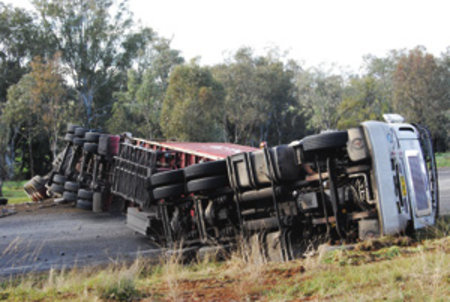 The overturned B-Double truck 2km south on the Boorowa Road The overturned B-Double truck 2km south on the Boorowa Road
.
‘A Canberra man was lucky to escape without serious injury after the B-Double truck he was driving along the Boorowa Rd overturned at 6.15am on Wednesday morning. The 42 year old man lost control of the vehicle 2km south out of town and ran off the road, before the entire truck overturned and spilled out over both lanes of the road.
The overturned truck was carrying furniture and concrete slabs and left more than a dozen slabs scattered over the road. Local resident Russell Denning said he heard a ‘monstrous bang’ when the truck crashed on the road near his home.
Senior Constable John Newton said a lack of attention from the driver appears to be the cause of the accident but police are still investigating.
“At this stage it appears the driver was distracted but there are still final enquiries to be completed,” he said. “My understanding is the driver will receive an infringement for negligent driving.”
.
Tags: B-double crashes, b-doubles, Blackheath Highway Action Group, Blue Mountains, Great Western Highway, head-on, Menangle Bridge, Mt Victoria bypass, RTA, truck collision, trucking expressway, Urunga, walls of death
Posted in Blue Mountains (AU), Threats from Road Making | 5 Comments »
Add this post to Del.icio.us - Digg
Leave a Reply
You must be logged in to post a comment.
February 1st, 2012
It’s a remarkable photograph: A pregnant Orang-utan protectively clutching her five-year-old child as death seems imminent at the hands of bounty hunters armed with knives.
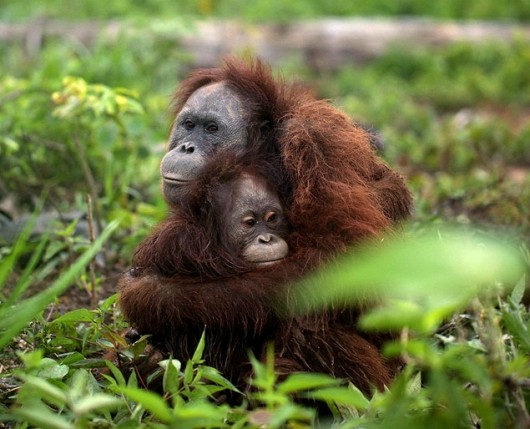 Ordeal…the mother and baby Orang-utan, above, were lucky to have escaped
a group of juvenile Indonesian poachers (below) in Kalimantan (Borneo)
(© Photo by Vier Pfoten of Four Paws International, ^http://www.four-paws.org.uk/ and Ordeal…the mother and baby Orang-utan, above, were lucky to have escaped
a group of juvenile Indonesian poachers (below) in Kalimantan (Borneo)
(© Photo by Vier Pfoten of Four Paws International, ^http://www.four-paws.org.uk/ and
PT Restorasi Habitat Orangutan Indonesia (RHOI)
^http://forest-carbon.org/project-list/first-project)
.
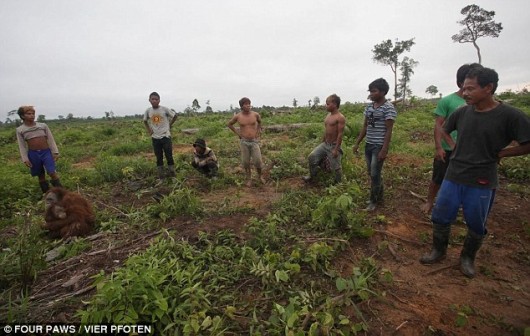
At The Habitat Advocate we wish to emphasise and thank the vital role of wildlife photographers around the world whose photos continue to help convey the plight of wildlife at the hands of humans. Without such photos, the truth would be less disseminated.
The following article was reproduced in The Sun-Herald newspaper (Sydney) on 20120129 on page 30. The article was borrowed from the New York Daily News newspaper (New York) which published the article on 20120127. The original source was the Daily MAIL (UK), written by Richard Shears, 20120127, under the long heading: ‘Don’t hurt my baby! Pregnant Orang-utan protectively hugs her daughter as ruthless Borneo bounty hunters move in for the kill‘.
The ultimate source is from the website of Four Paws UK.
Four Paws International is an international animal charity, campaigning to end animal suffering and cruelty. Four Paws International was founded in 1988 in Austria to campaign against fur farms and against battery farmed eggs.
Visit their website (English office) : ^http://www.four-paws.org.uk/
The partner organisation based in Indonesia is PT Restorasi Habitat Orang-utan Indonesia (RHOI), which translates into English as the Borneo Orang-utan Survival (BOS). Its name could not be more literal! Humans are systematically exterminating a species – the Orang-utan.
BOS has developed an Ecosystem Restoration Concession with the intention of using the forest area as a release site for rehabilitated Orang-utans. The proposed concession is in East Kalimantan is comprised of the ex-PT Mugitriman International (MGI) timber concession. BOS would like to obtain sustainable funding for managing and safeguarding this forest and is currently exploring the option of an avoided deforestation/REDD project where the sale of carbon.
Visit their website: ^http://forest-carbon.org/project-list/first-project
.
.
‘Pregnant Orang-utan mother and child rescued at last minute from knife-bearing bounty hunters in Borneo’,
by Rolando Pujol in the New York Daily News, Friday, 20120127, ^http://www.nydailynews.com/news/pregnant-orangutan-mother-child-rescued-minute-knife-bearing-bounty-hunters-borneo-article-1.1013270?]
.
It’s a remarkable photograph: A pregnant Orang-utan protectively clutching her five-year-old child as death seems imminent at the hands of bounty hunters armed with knives.
At the last minute, however, members of Four Paws International, an international animal-rescue group, swooped in last week and prevented their killings in Borneo, the Daily Mail reported.
“A few minutes later and the Orang-utans could have been dead,” said Dr. Signe Preuschoft, a primate expert with the British-based organization, according to the Daily Mail. “We discovered a gang of young men surrounding them and both victims were clearly petrified.”
The incident showcases the threat Orang-utans are facing as they are targeted for slaughter with a price on their heads.
“The gang meanwhile were jubilant in anticipation of their rewards for catching and killing the animals.”
The incident, compellingly captured in a dramatic photo of the mother cradling her child for dear life, casts a fresh light on the disturbing plight of Orang-utans, who were once common throughout Southeast Asia but now mostly live in Borneo and other areas in Indonesia.
The mother, estimated to be between 25 and 30, and the child were the only Orang-utans the team found alive in the area surrounding a palm-oil plantation. The group said it was scouting the area after reports of mass Orang-utan slaughter.
The spread of palm oil plantations, the group said, is accelerating the demise of the already endangered animals, which are losing native habitat because of widespread deforestation. The very name Orang-utan means “person of the forest,” as they spend most of their time in trees.
.
The palm-oil companies, the group said, are allegedly making matters worse by offering rewards of about $100 per dead Orang-utan, because they see the animals as nuisances.
.
“These massacres must not be allowed to continue,” Preuschoft said to the Daily Mail.
The rescued animals have since been released back in the wild in an area far from where they almost met death. The mother was fitted with a radio transmitter to help ensure the apes stay safe, the group said.
“Tens of thousands of adult Orang-utans have been slaughtered, while their orphaned offspring is frequently being sold off as pets or left behind to die, if they aren’t killed on the spot as well“, Four Paws International posted on its website.
The slaughter of Orang-utans is illegal in Indonesia, but enforcement has stepped up only recently, the group said.
“Mass graves that were discovered last September triggered the first few serious arrests, including a senior plantation manager“, the group wrote.
.
A similar article (in more detail) by the Daily Mail (UK):
.
‘Don’t hurt my baby! Pregnant Orang-utan protectively hugs her daughter as ruthless Borneo bounty hunters move in for the kill’
[Source: ”Don’t hurt my baby! Pregnant Orang-utan protectively hugs her daughter as ruthless Borneo bounty hunters move in for the kill’, by Richard Shears, 20120127, Daily Mail (UK), ^http://www.dailymail.co.uk/news/article-2092722/Pregnant-orang-utan-hugs-daughter-bounty-hunters-Borneo-in.html]
.
- Pair saved at last minute by UK-based animal rescue group
- Palm oil firms trying to clear plantations said to be offering £70 for each Orang-utan killed on the Borneo palm oil plantations
.
As bounty hunters with bush knives entrapped them in a circle and moved in for the kill, the only thing this mother Orang-utan could think to do was to wrap a giant protective arm around her daughter. The pair seemed to be facing a certain death as a gang of hunters surrounded them in Borneo, keen to cash in on the palm oil plantations’ bid to be rid of the animals.
But, happily, a team from the British-based international animal rescue group Four Paws International arrived in time to stop the slaughter and saved their lives.
The pregnant mother and daughter were captured and moved to a remote and safe area of the rainforest and released back into the wild – but not before the mother was equipped with a radio device so she and her young can be tracked to ensure they remain safe.
‘Our arrival could not have been more timely,’ said Dr Signe Preuschoft, a Four Paws primate expert. ‘A few minutes later and the Orang-utans could have been dead.’
‘We discovered a gang of young men surrounding them and both victims were clearly petrified.
‘The gang meanwhile were jubilant in anticipation of their rewards for catching and killing the animals. These massacres must not be allowed to continue.’
Saved: ‘Our arrival could not have been more timely. A few minutes later and the Orang-utans could have been dead’ said Dr Signe Preuschoft, a Four Paws primate expert
‘A few minutes later and the Orang-utans could have been dead.’ said Dr Signe Preuschoft, a Four Paws International primate expert
Mother and daughter were captured and moved to a remote and safe area of the rainforest and released back into the wild – but not before the mother was equipped with a radio device so she and her young can be tracked to ensure they remain safe.
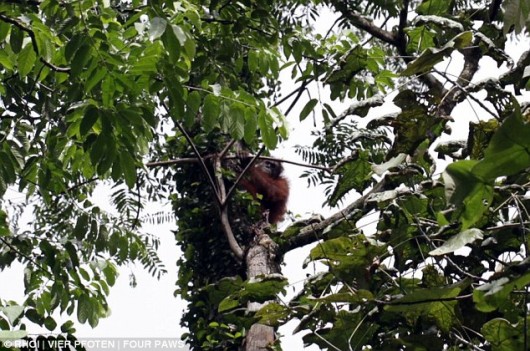 Mother and baby rescued and placed into the wild.
But with their rainforest wilderness rapidly being destroyed how long have these Orang-utans got? What happened to the father? Mother and baby rescued and placed into the wild.
But with their rainforest wilderness rapidly being destroyed how long have these Orang-utans got? What happened to the father?
.
Before the rescue, a Four Paws International team had scoured the area on the Indonesian side of Borneo, which is shared with Malaysia, but found no other Orangutans which had survived an earlier slaughter.
.
Deforestation has dramatically reduced their habitat and their numbers have dropped from 250,000 a few decades ago to only 50,000 in the wild. And while the loss of their habitat by logging companies has created a major threat to their existence, a more brutal form of reducing their numbers has emerged in recent years – direct slaughter.
.
Palm oil is used in hundreds of products from chocolate to oven chips, but the demand for buying it at a low price has resulted in significant deforestation as habitats are being destroyed to make way for plantations. Some palm oil companies see Orang-utans as pests, a threat to their lucrative business, and have placed a bounty on their heads.
Company executives are reported to be offering up to £70 to employees for each Orang-utan killed on the palm oil plantations. While such stories were at first denied, proof of the slaughter emerged last September when graves and bones were found by investigators.
‘Killing of Orang-utans is illegal in Indonesia but the law is lacking enforcement,’ said a Four Paws UK spokesman.
‘Before November last year only two low-level arrests had ever been made. But in the last two months 10 more arrests have taken place including the arrest of the senior manager of the plantation where the worst graves have been found.’
In an equally tragic scenario, babies left alive after adult Orang-utans have been slaughtered have been put up for sale in the Pet Trade by hunters.
When traumatised babies are found by Four Paws International and other animal rescue teams they are taken to a sanctuary and taught skills they will need in order to return to the wild.
.
.
Selected comments from readers:
.
‘Boycott any product with palm oil!!!’
~ maninthemiddle, 20120128.
.
“Let’s find the corporate entities who are paying for the palm oil,then boycott,very sad story,very touching”
~ olefan_is_a_moron, 20120128.
olefan_is_a_moron (20120128):.
“The real problem in the world is overpopulation. Natural resources replace themselves unless they are overburdened by excessive demand due to a big population. Cutting down 1% of a forest will not harm it since trees will just grow back but when you’re destroying too much at once you’re just striping the land bare.”
~ DocPaul (20120128)
.
“Soon man shall be the only “animal” left for hunting.”
~ 3 VULTURES (20120128).
.
“Orang-utans are critically endangered in the wild because of rapid deforestation and the expansion of palm oil plantations into their rainforest home. The situation described in this article is all too common unfortunately. If nothing is done to protect these amazing creatures, they will be extinct in just a few years. Visit the Orangutan Outreach website to learn more and make a difference! http://redapes.org Reach out and save the orangutans! Adopt an orangutan today! {:(|}”
~ OrangutanOutreach (20120128).
.
“How about a bounty of $150 per dead bounty hunter?”
~ Meowmeister, 20120128.
.
“This is what happens when you have: 1. People believing that the so-called phrase “and man shall have dominion over the beasts” means they can be killed at will and 2. When human beings believe nothing absolutely nothing is more important than profit.”
~ itsallinperception, 20120128.
.
“Farmers are being killed in south America for the same reason, land. Plantation owners want the land to get money for carbon credits…”
~ nlohu, 20120128.
.
“So sad. Palm oil is not just used in food. It is also used in cosmetics. I think it is called retinyl palmitate, something like that. Any ingredient that has “palmitate (ie: palm) is from palm oil. It is a form of vitamin A, used in skin creams alot.”
~ ana63, 20120128.
.
“These companies should not be allowed to trade in the UK. We shouldn’t be trading with any company that doesn’t respect life and the environment.”
~ Lo, cheshire, UK, 20120128.
.
“Everything that is wrong with the world is due to humans. We will continue to destroy our world unless something radical happens to reduce the human population and to change the greedy mindset of the human population. This makes me so incredibly sad!”
~ GB, UK, 20120128.
.
“…I think what would be more helpful is to have the names of the food manufacturers who are purchasing the palm oil from those companies. I suspect we would see major names such as Nabisco, Kraft, etc.”
~ InfoOverload, 20120128.
.
.
ANSWER: The largest palm oil company worldwide is ‘Wilmar International’
.
One of the most powerful opponents of our ‘Save our Borneo’ activists is Wilmar International, the largest palm oil company worldwide, based in Singapore.

“Wilmar International Limited, founded in 1991, is Asia’s leading agribusiness group.
“We are amongst the largest listed companies by market capitalisation on the Singapore Exchange. Our business activities include oil palm cultivation, oilseeds crushing, edible oils refining, sugar, specialty fats, oleochemicals and biodiesel manufacturing and grains processing. Headquartered in Singapore, Wilmar has over 300 manufacturing plants and an extensive distribution network covering China, India, Indonesia and some 50 other countries to support a well established processing and merchandising business. Wilmar also manufactures and distributes fertilisers and owns a fleet of vessels. The Group is backed by a multi-national workforce of approximately 90,000 people.”
“We are today:
- The largest global processor and merchandiser of palm and lauric oils
- One of the largest plantation companies in Indonesia/Malaysia
- The largest palm biodiesel manufacturer in the world
- A leading consumer pack edible oils producer, oilseeds crusher, edible oils refiner, specialty fats and oleochemicals manufacturer in China
- One of the largest edible oils refiners and a leading producer of consumer pack edible oils in India
- The largest edible oils refiner in Ukraine
- The leading importer of edible oils into East Africa and one of the largest importers of edible oils into South-east Africa.
‘We will continue to leverage on the scale and strengths of our business model to benefit from the long term growth potential of the agricultural commodity business, especially in Asia.”
Visit website: ^http://www.wilmar-international.com/
.
.
Cyclone Yasi 2011 destruction sees Wilmar take over Australia’s CSR’s Sucrogen
.

[Source: ‘ Proserpine creditors approve sale of mill to Sucrogen‘, 20111209, ^ http://www.sucrogen.com/media/news]
.
‘Sucrogen, the Australian-based sugar subsidiary of Singapore-listed Wilmar International Limited, looks forward to an exciting future as the new owner of Proserpine Sugar Mill after a majority of Proserpine creditors, by number and value, voted today to approve Sucrogen’s purchase of the mill.
Sucrogen CEO Ian Glasson said the creditors’ vote was a great outcome and paved the way for the sale transaction to be completed immediately.
“The positive result means creditors will be paid, in full, before Christmas,” Mr Glasson said. “We are grateful to have received such strong support from creditors, who have clearly shown faith in us and our plans for the Proserpine region.”
Sucrogen’s offer comprised a headline price of A$120 million, plus a working capital adjustment, normal settlement adjustments, as well as absorption of the mill’s normal operating costs and certain critical capital expenditure incurred from 31 October 2011.
Mr Glasson said while Sucrogen was pleased to finally purchase the mill, it was disappointing the sale was not possible before the Co-operative was placed into voluntary administration.
“The negative campaign Tully ran to derail the first two member votes has, ultimately, cost members a substantial amount of money in administration and legal fees,” he said. Critically, it has also delayed capital and maintenance at the mill.”
However, the transition to Sucrogen management and leadership will begin immediately and we will hit the ground running next week and do our best to ensure the mill is ready for the start of 2012 season, despite the lengthy delays.”
Mr Glasson said Wilmar had expressed a strong interest in working with growers to help expand Proserpine’s sugar industry.
“We look forward to a long and productive relationship with local growers, Proserpine Sugar Mill employees and the whole Proserpine community.”
.
So the company that is behind the palm plantation clearing destroying Orang-utan habitat and encouraging Oran-gutans to be slaughtered, is the parent company that sells CSR Sugar across Australia and Chelsea Sugar across New Zealand and the artificial sweetener ‘Equal‘.


.
.
The palm oil industry says: ‘Orang-utans are pests!’
[Source: ^http://www.rainforest-rescue.org/newsletter/1267/282c3e5ec03e375e7afa82c63564ae41]
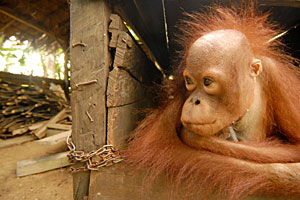 This juvenile Orang-utang’s mother was killed on one of the palm oil plantations This juvenile Orang-utang’s mother was killed on one of the palm oil plantations
.
“Dear friends of the rainforest, the BBC reports that Orang-utans are treated as “pest” and exterminated on Indonesian and Malaysian palm oil plantations. In the last year alone, up to 1,800 Orang-utans were killed in Kalimantan (Indonesian Borneo). They wander hungry through the plantations as though in a daze, looking for food and thus eat the palm seedlings. Palm oil plantation workers are paid to kill Orang-utans either before a forest is cleared or, if they see any in a plantation. Either way, it is totally illegal to harass, harm or kill any Orang-utans.”
[Source: ”Borneo: Environmentalists need help for preserving the rainforest’, ^https://www.rainforest-rescue.org/donate/90/borneo-environmentalists-need-help-for-preserving-the-rainforest]
.
“The current trend of converting rainforest into palm oil plantations is devastating our country. Our people cannot provide for themselves any longer; and endangered species such as the Orang-utans are doomed to die. It is high time for us to join forces and jointly put a stop to the palm oil industry’s illegal activities on all levels.“
Nordin, head and founder of our partner organisation ‘Save our Borneo’ (SOB) has lately experienced a great deal of suffering caused by the destruction of tropical rainforest in his home province Central Kalimantan in Borneo – including his own family. His little son Mirza was born when wildfires were raging for several months, obscuring the sky over Central Kalimantan and making breathing truly agonizing. Due to his chronic breathing difficulties, Mirza had to be hospitalised often. Even though slash and burn clearing methods are prohibited in Indonesia, fires are started again and again in order to gain more space for palm oil plantations.
One of the most powerful opponents of our ‘Save our Borneo’ activists is Wilmar International, the largest palm oil company worldwide.
.
(Wilmar International) act as if no rules apply to them. This company has the rainforest illegally logged and new plantations set up; they drive peasants off their land and arrest them if they defend themselves. Wilmar keeps founding new subsidiaries, and bribes officials to side-step the law.
.
Therefore, Save Our Borneo’s boss Nordin sent ‘Rainforest Rescue’ a strategic plan in order to unite our efforts and take action against Wilmar: We are also supported by regional environmentalists of ‘Walhi’, the Indonesian branch of ‘Friends of the Earth’.
.
“We want to sue the Wilmar Group at their headquarters in Singapore for their crimes committed against humans and nature,“ says Nordin. “However, first we will have to gather enough detailed facts and evidence for an absolutely watertight lawsuit.”
.
Their strategic plan is set to run for 18 months and works on all levels, including:
- Workshops with affected peasant families to discuss land rights and, possibly, draw up maps. Another goal is to inform the population about Wilmar’s modus operandi and how to defend themselves.
- Training in Forest Management and Land Rights
- Research and data gathering regarding activities of Wilmar subsidiaries.
- Workshops on corruption
- Public relations activities disclosing Wilmar’s law violations as well as any political involvement (multimedia campaign on TV, radio or the internet such as facebook, brochures etc.)
- Public dialogues between all the parties involved, having politicians, scientists, journalists, environmentalists and victims of the palm oil industry all sit together at one table.
.
Nordin calls his major offensive against Wilmar International an “Action Plan for a Better Life“.
Visit Rainforest Rescue website: ^http://www.rainforest-rescue.org/
.
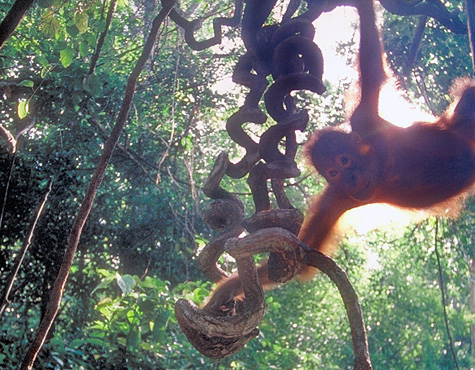
.
Tags: Borneo, Borneo Orang-utan Survival, Chelsea sugar, CSR sugar, Four Paws International, Indonesian farmers, Indonesian palm oil plantations, Kalimantan, Malaysian palm oil plantations, orang-utan, orang-utan bounty hunters, palm oil plantations, PT Restorasi Habitat Orangutan Indonesia, Sucrogen, wildlife photographers, Wilmer International
Posted in Kalimantan (ID), Orang-utans, Threats from Farming, Threats from Poaching and Poisoning | No Comments »
Add this post to Del.icio.us - Digg
Leave a Reply
You must be logged in to post a comment.
January 28th, 2012
Since 12thMay 2005, Blue Mountains Swamps have been listed as an endangered ecological community under the Environmental Protection Biodiversity Conservation Act 1999, (EPBC Act), as amended in 2005. Blue Mountains Swamps are listed under the scientific category of Temperate Highland Peat Swamps on Sandstone.
The objectives of the EPBC Act include providing for the protection of the environment, especially matters of national environmental significance and to conserve Australian biodiversity. In the case of Blue Mountains Swamps, the EPBC Act serves to prevent the actions of land use developers and others posing a significant impact upon the integrity of these vital swamp ecosystems.
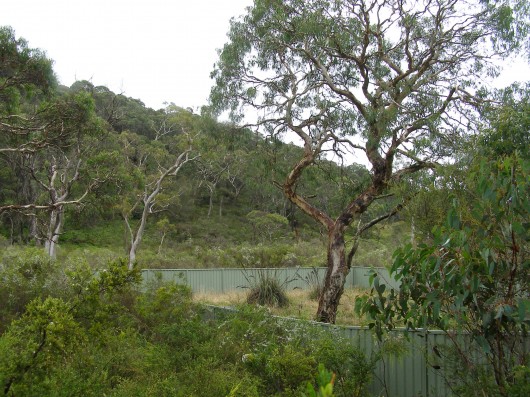 A Blue Mountains Swamp
…blatantly slashed, reclaimed and exotic grass introduced by this property development
on the wild edge of Katoomba, adjacent to the Greater Blue Mountains World Heritage Area. A Blue Mountains Swamp
…blatantly slashed, reclaimed and exotic grass introduced by this property development
on the wild edge of Katoomba, adjacent to the Greater Blue Mountains World Heritage Area.
.
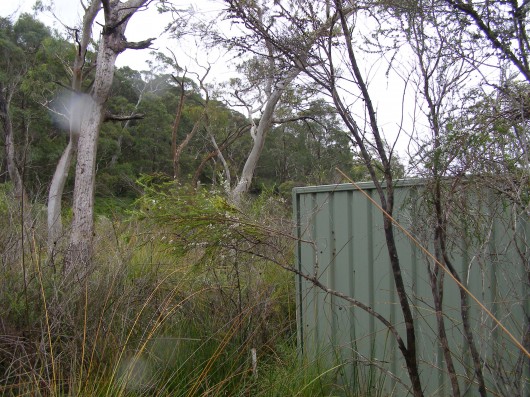 The steel fence of the development is built right into the Blue Mountains Swamp
(Photo by Editor 20120118, free in public domain, click to enlarge) The steel fence of the development is built right into the Blue Mountains Swamp
(Photo by Editor 20120118, free in public domain, click to enlarge)
.
This housing development was approved by Blue Mountains Council.
At the same time, Blue Mountains Council’s Upland Swamp Rehabilitation Programme was commenced in 2006 after Blue Mountains Swamps were listed as part of the Temperate Highland Peat Swamps on Sandstone endangered ecological community, with the aim of protecting and restoring Blue Mountains Swamp across the Local Government Area (LGA).
“In August 2008 Blue Mountains Council and Lithgow Council formed a partnership to deliver the ‘Saving our Swamps’ (S.O.S) project to restore Temperate Highland Peat Swamps on Sandstone across both LGAs. With grant funding of $250,000 over 3 years from the Urban Sustainability program of the NSW Environmental Trust, the SOS project will both strengthen Blue Mountains Council’s long term Upland Swamp Rehabilitation Programme and transfer skills to build the capacity of Lithgow Council to protect the Newnes Plateau Shrub Swamp endangered ecological community of the Newnes Plateau.”
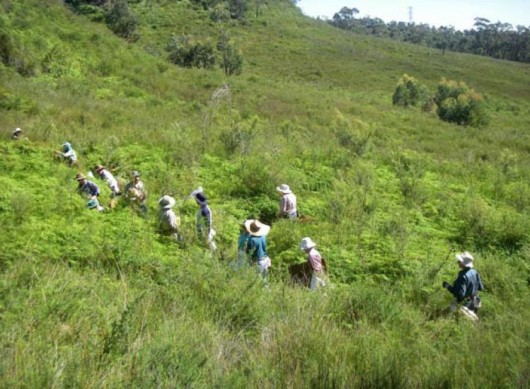 Local community volunteers helping Blue Mountains Council
to rehabilitate Kitty Hawk Swamp at Wentworth Falls in the Blue Mountains
[Source: Blue Mountains Council’s ‘Swampwatch’ Factsheet 7) Local community volunteers helping Blue Mountains Council
to rehabilitate Kitty Hawk Swamp at Wentworth Falls in the Blue Mountains
[Source: Blue Mountains Council’s ‘Swampwatch’ Factsheet 7)
.
“The SOS initiative will build on the Blue Mountains Council’s Upland Swamp Rehabilitation Programme, by providing funds for bush regeneration, soft engineering swamp re-hydration and creek bank stabilization in degraded Blue Mountains Swamps on both public and private land. The project will also deliver a community and school education program to raise awareness of the significance of Blue Mountains Swamps and their associated threatened species and to explain how the community can assist in their protection.
The successful partnership between BMCC and LCC was expanded in 2009 to incorporate Wingecarribee Shire Council and Gosford Council. The resultant SOS stage 2 project received a $400,000 federal Caring for Country grant over 12 months to expand the model across all four LGAS under the leadership of Blue Mountains Council.”
[Source: ^ http://saveourswamps.com.au/Blue-Mountains-City-Council.php]
.
Am I missing something here?
Blue Mountains Council receiving $250,000 plus $400,000
to save Blue Mountains Swamps,
while approving development into them?
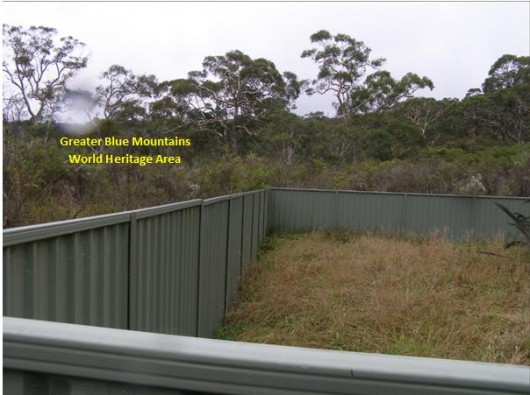 Saving Our Swamps by Council-approved slashing, bulldozing and reclamation
This is immediately adjacent to the Greater Blue Mountains World Heritage Area.
. Saving Our Swamps by Council-approved slashing, bulldozing and reclamation
This is immediately adjacent to the Greater Blue Mountains World Heritage Area.
.
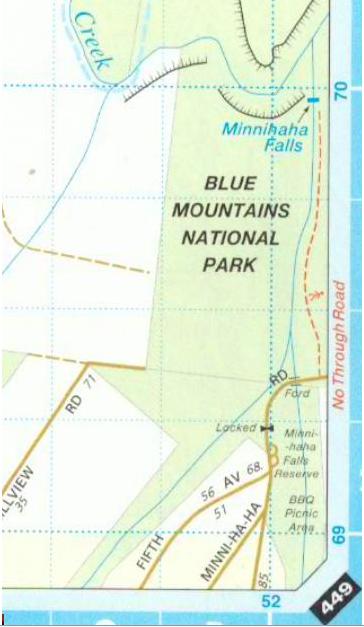 Location of Fifth Avenue adjacent to Blue Mountain National Park (BMNP)
BMNP forms part of the Greater Blue Mountains World Heritage Area. Location of Fifth Avenue adjacent to Blue Mountain National Park (BMNP)
BMNP forms part of the Greater Blue Mountains World Heritage Area.
.
“This park, which is part of the Greater Blue Mountains World Heritage Area, protects an unusually diverse range of vegetation communities. There are rare and ancient plants and isolated animal populations tucked away in its deep gorges.”
[Source: NSW Office of Environment and Heritage, NSW National Parks and Wildlife Service, ^http://www.environment.nsw.gov.au/nationalparks/parkHome.aspx?id=N0004]
.
Leave a Reply
You must be logged in to post a comment.
|
|
 The disappearing urban forest of Ku-ring-gai, Sydney’s North Shore
Biodiversity-linkages within Urban Forest are provided by
connecting gardens, street trees, golf courses, ovals and parks.
The disappearing urban forest of Ku-ring-gai, Sydney’s North Shore
Biodiversity-linkages within Urban Forest are provided by
connecting gardens, street trees, golf courses, ovals and parks. …however improper zoning allows biodiversity linkages to be lost
when land area and soils are cumulatively removed.
…however improper zoning allows biodiversity linkages to be lost
when land area and soils are cumulatively removed. Blue Gum High Forest
Nearby Berowra Valley Regional Park
[Source: ^http://www.wildwalks.com/bushwalking-and-hiking-in-nsw/berowra-valley-regional-park/blue-gum-walk-joe-s-mountain-circuit.html]
Blue Gum High Forest
Nearby Berowra Valley Regional Park
[Source: ^http://www.wildwalks.com/bushwalking-and-hiking-in-nsw/berowra-valley-regional-park/blue-gum-walk-joe-s-mountain-circuit.html]
 The relative position of Ku-ring-gai
on the northern outer tentacles of Sydney Metro sprawl
(Google Maps, 2012)
.
The relative position of Ku-ring-gai
on the northern outer tentacles of Sydney Metro sprawl
(Google Maps, 2012)
.
 .
. Kelly and Keneally
Pro-development NSW Labor planning ministers of yore
Sydney growthist lobby mantra – “Sydney must grow!”
Kelly and Keneally
Pro-development NSW Labor planning ministers of yore
Sydney growthist lobby mantra – “Sydney must grow!”
 ‘Blue Gum High Forest’
in and around Ku-ring-gai
‘Blue Gum High Forest’
in and around Ku-ring-gai
 As sites are cumulatively cleared, the very basis for fragile Urban Forest
(i.e. rich soils and seed-bank)
is being excavated and removed forever by Improper Planning.
As sites are cumulatively cleared, the very basis for fragile Urban Forest
(i.e. rich soils and seed-bank)
is being excavated and removed forever by Improper Planning.
 Replacement building side set-backs leave no room for tall canopy trees,
which once formed bio-links.
Improper Zoning permits a footprint totally inappropriate
for an Environmentally Sensitive Area (ESA)
Replacement building side set-backs leave no room for tall canopy trees,
which once formed bio-links.
Improper Zoning permits a footprint totally inappropriate
for an Environmentally Sensitive Area (ESA)
 Blue Gum High Forest site damaged by “moonscaping” unassessed under one LEP.
Damage from an adjacent development is cumulatively allowed under another LEP.
Blue Gum High Forest site damaged by “moonscaping” unassessed under one LEP.
Damage from an adjacent development is cumulatively allowed under another LEP.
 Building too close to established trees is the result of urban densification in Urban Forest.
The cumulative impact of inappropriate zoning is further tree removal.
Building too close to established trees is the result of urban densification in Urban Forest.
The cumulative impact of inappropriate zoning is further tree removal.
 Mount Ku-ring-gai walking track
Mount Ku-ring-gai walking track
 Six-lane freeway carved into Mount Ku-ring-gai
Six-lane freeway carved into Mount Ku-ring-gai
 Urban Forest Strategy is a reality in nearby North Sydney
Urban Forest Strategy is a reality in nearby North Sydney
















































































Minister for “sustainable” population, Tony Burke, refused to set an “arbitrary” population number for Australia, despite research and advisory panels. As it is, it is growth, growth and more growth without a target, plan or limit. Immigration levels keep increasing, and many visas are uncapped. Where are people meant to live? While economists and governments might admit that prolific breeding of animals can cause them to consume their space and natural resources, such impacts of overpopulation makes humans exempt! The property investment and development industry is a powerful lobby group, and they demand perpetual economic growth to fill their properties! Tony Burke must do his duty, and replace Growth-based immigration levels with Replacement-levels of immigration – and stabilize our population before our cities, our lifestyles, and natural assets are destroyed.